News
News
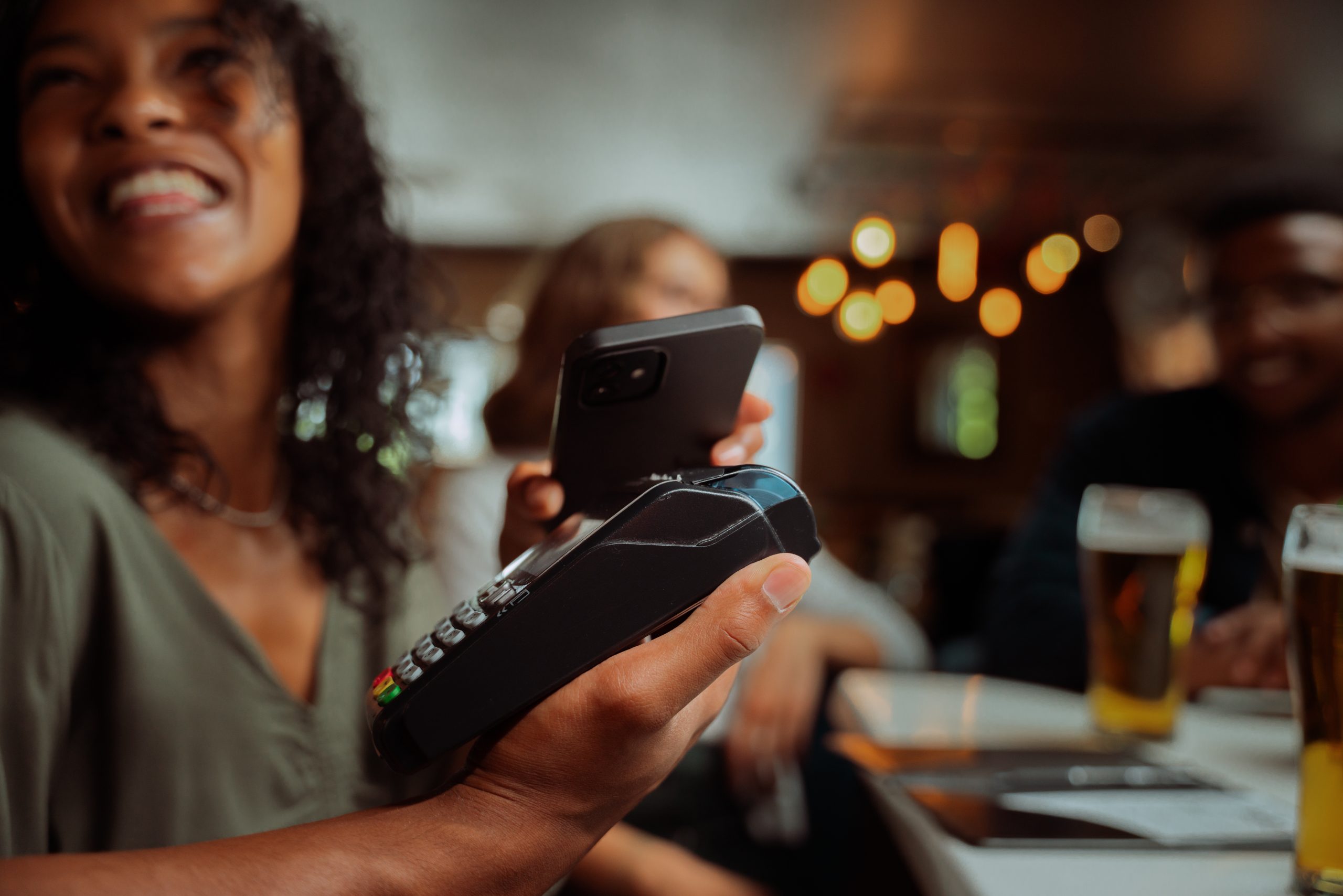
Consumer Payment Behaviour in Australia
The results of the Reserve Bank’s 2022 Consumer Payments Survey show that consumers continue to shift from using cash to electronic payment methods – a trend that was accelerated by the COVID-19 pandemic and consumers’ preference towards using debit and credit cards and making payments online. Consumers are also increasingly using more convenient payment methods, particularly contactless card payments, by tapping their card or phone. Cards are now used for most in-person payments, even for small transactions that used to be made mostly with
cash.
Source: www.rba.gov.au

For Australia’s financial sector, digital trust is the new currency
As adoption of banking apps grows, so does pressure to increase the range of capabilities the apps support, which has security ramifications.
Mobile app-based banking continues to find favour with Australians: more than two-thirds now use a mobile banking app or smartphone to do their banking, and it offers the highest customer satisfaction rating of any banking channel, averaging an 89.4% rating by customers of the ‘Big Four’.
As digital and self-service have been embraced by consumers, particularly in the form of increased use of apps, there’s inevitably pressure to build on that foundation.
A review of the apps of the five major Australian banks mid last year found customers wanted to see more capabilities and functionality added to the apps, particularly around money movement and management to improve financial wellbeing.
Some of these capabilities are being added in via third-party developed plugins created by fintechs, while other banks and credit unions are seeking to code these capabilities and features directly into the apps themselves.
Whichever app expansion strategy is pursued, a key concern will be that the additional functionality brings with it additional security risks. The larger the range of functions that the app can perform, the greater the amount of data it is likely to be handling.
All of these functions combine to create a broad potential attack surface for threat actors, who may view an ever-expanding banking app as a target that continues to increase in value.
Good security provides the confidence to expand apps
In a recent Deloitte survey, building digital trust was rated as the most important business strategy for success by financial institutions in the Asia-Pacific.
One of the top five benefits that cybersecurity investments had in this area was providing “confidence to try new things”, the survey found.
This means that at least in some banks, there’s a direct link between security and app capability growth; if a bank or credit union lacks confidence in their setup, they are less likely to try new things that could increase their security risk or exposure.
Banks and credit unions alike are acutely aware of their critical infrastructure role in Australia, and of the impact that a breach could have on customer confidence and goodwill. The critical nature of banking apps is often on display if they suffer downtime or degraded performance. Customer sentiment can turn quickly if they suddenly cannot perform critical tasks such as contactless payments at a supermarket register. And to be clear: these incidents aren’t often security-related. A security-related impact could prove catastrophic, particularly from an erosion of digital trust perspective, let alone what exposures individual customers could have.
Fortunately, credit unions and banking institutions tend to take a very proactive, best-practice approach to cybersecurity, and this extends to the oversight of their apps.
Many, for example, have focused on upskilling the defensive capabilities of their development teams. Without this education and verification, a lack of expertise may lead to teams taking shortcuts and/or lapsing into human errors, which could trigger configuration issues and code-level vulnerabilities.
Importantly for banks, these vulnerabilities could raise risk thresholds to a point that’s incompatible with, or in breach of, their regulatory requirements. Stringent regulations – including the Payment Card Industry Data Security Standard (PCI-DSS), the EU’s General Data Protection Regulation (GDPR) and additional global and national initiatives exist to address issues such as insecure data storage, insufficient authentication/authorisation, poor code quality and code tampering.
These standards create and drive vigilance among risk teams. In their pursuit of app expansion and increased customer satisfaction scores, it is important that developers or customer experience teams do not do anything that would undermine this vigilance and risk position.
Growing role-based security upskilling and awareness
To lay the foundations to proceed with banking app expansion with confidence, a holistic, people-driven security program is beneficial for creating the right mindset and foundational skills base.
A program that takes a dynamic approach based upon real-life threat management scenarios – as opposed to a static learning approach – will gain the most traction quickly. This can include the leveraging of motivational tools, such as rewards for successful “wins” and skills acquired.
Security learning pathways should also be available to everyone with a stake in the bank’s customer success. Developers are just one part of the ecosystem. Other parts of the organisation such as application security (AppSec) professionals and senior management also have key stakes in securing digital experiences and building digital trust. Executives, in particular, need to understand that security is not a “set it and forget it” discipline. A combination of tools and training is the most effective way to maintain the currency of security knowledge and best practices.
A positive security program focused on role-based education and awareness can lead to increased security engagement across the entire organisation, establishing the bank as “security-first.” From that position, unconstrained innovation can safely follow.
Written by Pieter Danhieux, CEO and Co-founder, Secure Code Warrior. Source: australianfintech.com.au

We’ve launched our PayTo service offering
Indue is excited to announce the official launch of its PayTo service offering, enabling financial institutions and payment service providers and platforms to drive payment innovation and improved customer experiences.
A development of Australian Payments Plus on it’s New Payments Platform (NPP), PayTo modernises the way bank accounts are used for payments, helping businesses and consumers thrive in the digital economy.
Indue CEO Derek Weatherley said the PayTo launch is a natural extension of Indue’s NPP capability, which has been helping Australia’s leading mutual and community banks take advantage of flexible, real-time payments with industry-leading financial crime support since 2018.
“At Indue, we are committed to investing in product technology advancements that support our client’s digital transformation, innovation, and competitiveness, exemplified now through PayTo,” Mr Weatherley said.
“We have a team of NPP experts that have already begun to connect partners to PayTo, delivering them a faster, simpler, and smarter real-time payment service.
“We are thrilled to be part of the PayTo revolution and, as always, are keen to help our current and future customers keep pace with the changing Australian payments landscape.
“PayTo will enable a superior payment experience by streamlining payments and improving efficiency and control for consumers and businesses. This is achieved by PayTo while at the same time reducing risks and modernising the way money moves.
“Ultimately, PayTo further enhances Indue’s digital banking offering, providing a state-of-the-art payment services experience for our customers.”
Indue can connect financial institutions, payment service providers and platforms to PayTo .
To learn more and get PayTo ready, click here.

The Mutual Bank Partnership
For 135 years, The Mutual Bank has met the financial needs of the Maitland, Newcastle, and Hunter communities in New South Wales, serving and supporting them in building a sustainable future.
Since March 2022, Indue has provided The Mutual Bank and its members with a significantly expanded payment services suite, including Direct Entry, BPAY, NPP, Financial Crimes, Anti-money laundering, Card Services, High Value Payments, and an expansion of its Digital Payments offering.
The Mutual Bank CEO Geoff Seccombe said the partnership continues to be driven by a strong alignment in company values, product offerings, and payment needs.
“Our relationship with Indue began when we needed assistance in becoming the first local mutual bank issuer of Apple Pay in the region. But it is founded upon much more than a vested interest in innovative payments technology,” Mr Seccombe said.
“Indue earned our trust, respect, and business by delivering on its payment services promise, and it has kept it by continuing to share our community-first focus and partnership culture.
“I commend Indue for its support of the local communities in which we operate, and its unwavering commitment to environmental, social, and cultural initiatives,” Mr Seccombe said.
Indue CEO Derek Weatherley said that alignment with our clients’ sustainability practices, community programs, and employee wellbeing are core to our values.
“The best partnerships are achieved when company culture and core values align, which is what we have experienced with The Mutual Bank,” Mr Weatherley said.
“We have an excellent understanding of The Mutual Bank’s priorities and their wider community goals in operating in a socially responsible manner, prioritising positive social impact and a genuine ‘one team’ support model with on-the-ground support.
“We look forward to continuing to work with The Mutual Bank and its community” Mr Weatherley said.
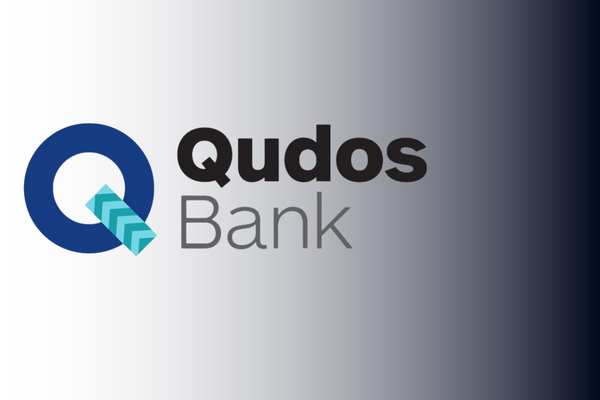
Qudos Bank selects Indue as their principal payments partner
We are delighted to confirm that Qudos Bank has reappointed Indue as their exclusive full-service payments partner.
Qudos Bank is one of Australia’s largest customer-owned banks with branches in Sydney, Melbourne and Brisbane and more than $5 billion in assets, offering a full range of financial products and services, including home loans, personal loans, transaction, and savings accounts, super and investing, and insurance.
Over recent years Qudos Bank has been on a digital transformation journey and provides a host of exceptional digital banking platforms and payments services. Qudos Bank CEO Michael Anastasi said the relationship renewal reaffirmed the strength and value of the long-term partnership with Indue to provide end-to-end payment services.
“We have a long term partnership with Indue and renewing the relationship supports continuing development in our innovation around digital banking offering and providing a state-of-the-art payment services experience for our customers, underpinned by market leading security in payments for our customers” Mr Anastasi said.
“Importantly, Indue’s customer-focussed culture is outstanding across the organisation and directly aligns to our central focus as a customer-owned bank on delivering banking services in the interests of our customers, providing synergies that will help Qudos remain at the forefront of excellent in customer service standards for our customers across Australia.”
Indue CEO Derek Weatherley said the renewal of the partnership will enable Qudos Bank to provide to their customers a comprehensive suite of end-to-end payment services coupled with market leading payment security. Qudos has been remarkably successful through a laser focus on customer advocacy and being easy to do business with – the partnership with Indue ensures that excellence in customer outcomes remains at the forefront of their business operations.
“Indue remains heavily invested in advancements in our product technology capability, reinvesting our profits into research and development via our Innovation Hub and the various working groups it supports and continuing to support the digital transition of our clients,” Mr Weatherley said.
“We couldn’t be more pleased Qudos Bank has chosen to extend our long-term partnership and we are looking forward to working together to build out future innovation pathways for real time, data rich, frictionless payment choices for customers. Qudos has been a great supporter of their community and we look forward to working closely with Qudos this year on supporting and driving community focused outcomes important to their organisation.
“The payment products and services suite provided to Qudos Bank by Indue will include NPP, PayID & Pay To, mobile payments, Orion Financial Crimes, Cards, Direct Entry, and BPAY services.”
-ENDS-
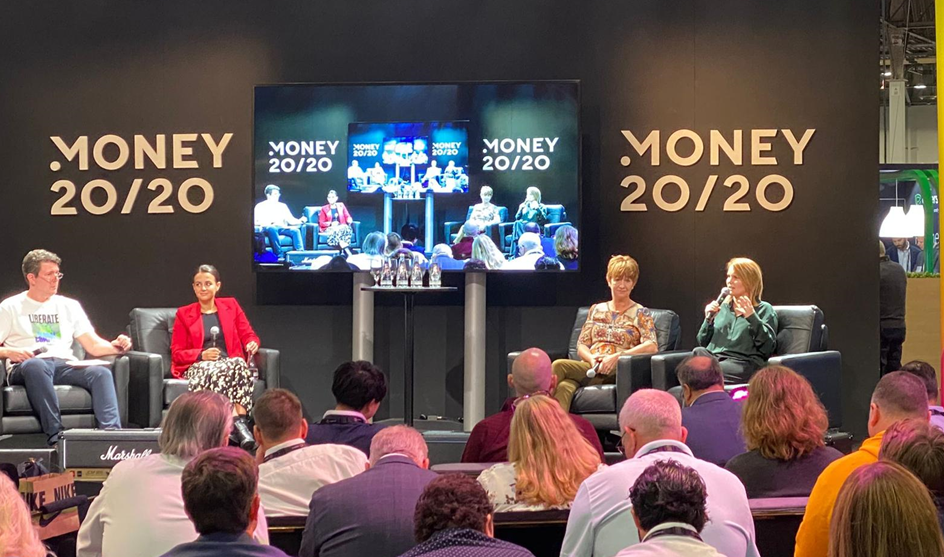
ID8 Tour | Money 20/20 – Blockchain & Crypto
Blockchain and
crypto have made a surprising resurgence to the agenda at Money 20/20, likely
driven by the growth in central bank currency pilots and collaborations into potential
use cases for government issued digital currency. The Indue client tour
participants absorbed broad learnings on how the concept of a fully digital
decentralised network could benefit customers and clients in the payments and
banking sectors.
A wide spread of
blockchain use cases were presented, everything from connected cars through to
micro payments, with the major feature being the ability to move money in
real-time at lower cost, a presumption that we see either prove or disprove
itself in the years to come.
The focus on the
use of crypto in payments has been heavily on enabling cross-border
transactions, as well as the challenges posed by increasing regulation.
The bold headline
from proponents of the technology at Money 20/20 was that everything will be on
blockchain – it’s only a matter of time.
This optimism
comes with words of warning. These technologies continue to be developed
through a cycle of uncertainty and regulation remains a major challenge. With
improved regulation we will likely see a more stable and genuine value emerge
for crypto and the development of more businesses with underlying strength.
With these
expansive developments in the fintech space, Indue continues to stay tuned to
these innovations to provide our clients and their customers with strategic
guidance and forethought on the payments landscape of the future.

id8 Tour | Money 20/20 Diversity & Culture
The Money20/20 conference has given us the opportunity to hear from a wide range of world-class speakers, including global entrepreneurs and even a Grand Slam tennis champion, who have all touched on the intrinsic link between organisational culture, diversity, and performance.
The companies that are best positioned to establish a competitive edge are the ones that embrace a culture of prioritising diversity of people and thought, and equally, this diversity is the best form of due diligence when developing new business models or entering new markets.
In a broad ranging discussion about fintech and start-ups featuring Serena Williams, we heard about new business models and solutions that are focused on solving problems for customers, leveraging the power of partnerships, and driving a competitive edge through organisational culture embracing diversity.
We were also fortunate to hear from several women who have founded new payment fintech companies in the past two years, including Kontempo – a Mexico-based bank focused on providing credit to small businesses, Lucy – which is providing funding for female entrepreneurs, and the competitive edge through embracing diversity was a recurring theme.
The theme of modernising core was prevalent, ensuring foundations are built on future proofed architecture. Another common theme in this vein was ‘build core, partner everything else’. This includes leveraging partnerships for insightful and innovative product design, and the theme of diversity featured again through partnerships that support organisational diversity, with a US Bank focussing a commitment to diversity though partnering with fintechs who are focused on minority/women only businesses.

A Look at Gen Z Banking Habits and Attitudes
Compared to other generations, fewer Gen Z customers expect to remain with their primary financial services organization a year from now. Do you know what Gen Z wants?
They are mobile-centric, diverse, ambitious and just starting their careers. They also have strong opinions on what they expect from their financial services organization. Our BAI Banking Outlook Special Report shares essential insights on Gen Z, the newest generation of banking customers.
Source: BAI 2022, www.bai.org

Cashless society looms: Australians tipped to move away from cash by 2025
Australians are ditching cash at the fastest rate in history as contactless payments and the boom of buy-now-pay-later methods threaten to radically reduce the use of physical money. The annual Global Payments Report predicts that in Australia, cash will account for only two per cent of value from all point-of-sale transactions by 2025. This doesn’t mean cash will only be used for two per cent of all transactions, but rather that the value of these cash purchases will pale in comparison to those made with other methods such as credit or debit cards.
The report also predicted that within two years, digital wallets (such as apps that allow customers to use their smartphone or smart device to pay) will overtake credit and debit cards to become the leading e-commerce payment method by 2024. Currently debit cards are most used payment method at the registers comprising 41 per cent of all transactions, followed by credit cards (35 per cent), digital wallets (11 per cent), cash (seven per cent) and buy-now-pay-later (four per cent). In Australia buy-now-pay-later services such as Afterpay are predicted to account for 14 per cent of all e-commerce purchases by 2025, up from its current 11 per cent. The steep decline in the use of cash comes as many Australians change their purchasing behaviour during the COVID-19 pandemic to avoid contact where possible. Analysis by the Australian Banking Association found that ATM withdrawals – perhaps the largest indicator of general cash use – decreased by 20 per cent in the year to August 2021. “COVID-19 accelerated trends in our society and changed the way we live our lives. Working from home will forever be more prominent within the workforce, we have steered away from using cash and as a result are seeing an increase in card and technology payments and the existing trend of doing banking online instead of in a branch has only continued,” said ABA chief executive Anna Bligh. “As we have seen more people go away from using branches, it’s no surprise to see banks invest in areas where customers prefer to bank, such as in their online platforms and apps. “Interestingly, one major Australian bank reported digital banking is now the primary channel for its customers aged between 16 and 69, with digital interactions up 10 per cent since 2019. This same bank reported a steady branch usage drop of 32 per cent since January 2019.” ABA data shows that one in ten Australians regularly leave home without taking their wallet, and more than one in three Australians use digital wallets on their smartphones at least weekly. As cash use declines, so too does the use of physical bank branches.
Source: 9news.com.au, Stuart Marsh, Senior Producer, 10/3/22

Auswide Bank appoints Indue as exclusive partner to deliver payments transformation
We are pleased to announce that Auswide Bank has selected Indue as their exclusive full-service payments partner.
An ASX-listed regional bank based in Bundaberg with 17 branches across Queensland, Auswide Bank has operated for more than 55 years with assets under management of more than $4 billion.
Auswide Bank has an Australia-wide lending presence supported through branches, business bankers, accredited mortgage brokers and online, and offers an extensive range of finance and banking products to help their customers realise their financial dreams.
Auswide Bank Managing Director Martin Barrett said the partnership announced today strengthens an already proven relationship, with Indue to provide end-to-end payment services that will support the bank’s digital transformation, provide a state-of-the-art customer experience and business outcomes.
“Auswide Bank has worked with Indue for 6 years and the extension of agreement is another exciting step in our relationship,” Mr Barrett said.
“Both organisations are focused on placing our customers at the centre of everything we do, and we couldn’t be more pleased to be partnering with Indue to help us continue to deliver outstanding service to our communities and customers across Australia.
“Indue will provide a full suite of end-to-end payment solutions, which is a key component of transforming our business with technology and providing digital payment choices for our customers, improving their experience and delivering stronger business outcomes.”
Indue CEO Derek Weatherley said Auswide Bank’s strategy was strongly supported by Indue’s strategy and Indue was very well placed to serve Auswide Bank in their mission to serve their customers.
“At Indue we have a deep commitment to our partners, and our ‘customer first’ approach is directly aligned to Auswide Bank’s focus on their customers and community,” Mr Weatherley said.
“This new partnership will provide Auswide Bank customers with access to a comprehensive suite of end-to-end payment services delivered through Indue’s ongoing digital transformation program.
“Indue reinvests our profits into research and development to ensure our customers are continuously able to deliver relevant payment solutions to their customers. Auswide Bank and its stakeholders will be a major beneficiary of these investments as we continue to develop and deliver these innovative payment solutions.
“Auswide Bank will benefit by tapping into Indue’s evolving suite of digital payments that bring real time, data rich, frictionless payments to customer’s anywhere, anytime, with the peace of mind brought by our market leading real time fraud and AML capabilities.
“The payment services suite provided to Auswide Bank will include Direct Entry, BPAY, NPP, Financial Crimes, Anti-money Laundering, Card Services, High Value Payments and PEXA. Auswide Bank plan to launch NPP and NPP Fraud as a matter of priority.”
Mr Weatherley said the teams were looking forward to working together for a swift transition over coming months.
-ENDS-
For more information please contact:
Indue Head of Marketing & Communications – Clare Mitchell
[email protected] – 0429 889 556
Auswide Bank Head of Marketing – Karyn Kelly
[email protected] – 0414 011695

Indue becomes Tier 1 BECS member
Payments solutions provider Indue today announced it has become a Tier 1 Participant Member of the Bulk Electronic Clearing System (BECS), the low-cost work horse of the Australian payments system, which processes more than $14 trillion Direct Entry transactions annually.
Indue Chief Executive Officer Derek Weatherley said he was pleased that Indue had transitioned seamlessly from a Tier 2 to a Tier 1 participant in BECS. This was a major industry change and went ahead without disruption to our clients, their customers or other industry participants. This change is also significant because organisations seeking a Tier 1 sponsor now have broader choice in a traditionally limited market.
“This was a seamless transition for our valued clients, and importantly this move future proofs our Direct Entry offering against decisions made by banks or other third parties. We now control our own destiny in respect of Direct Entry service continuity for the future, as we no longer rely on other parties to assure service continuity. This is important to our clients as they navigate a shifting state of play in account to account payments in the coming years.
“This change rounds out our position as a Tier 1 provider of all account-to account payment systems, complementing our New Payments Platform offering and our real time account to account Orion fraud solution” Mr Weatherley said.
Indue currently provides Direct Entry services to a large and diverse customer base including Mutual Banks, Credit Unions, Banks, Mortgage Originators, Gift and Prepaid Solution Providers, Government Agencies, ATM Operators, FinTechs and Church Funds, processing over AUD$75 billion annually.
ENDS
For more information please contact:
Clare Mitchell – Head of Marketing & Communications
[email protected]

The Mutual Bank appoints Indue as their principal payment partner
Today we are delighted to confirm that The Mutual Bank has chosen Indue as their principal payments partner.
The Mutual Bank, a $1 billion mutual bank based in the Hunter region of NSW, has been serving the people of the Hunter since 1888. It offers a full range of financial products and services, including home loans, transaction and savings accounts, digital banking and payments services, credit cards, business banking and insurance.
The partnership will provide The Mutual Bank and its members with access to Indue’s comprehensive suite of end-to-end payment services delivered through Indue’s ongoing digital transformation program, which has focused on major investments key to the mutual sector.
The Mutual Bank CEO Geoff Seccombe said ‘the relationship formed today strengthens an already proven partnership that started with a digital payment solution and is now moving to end to end payment services’.
Indue CEO Derek Weatherley said ‘The strategic partnership with The Mutual Bank reflects the relevance of our ‘member first’ ethos as well as the strength of our product roadmap for the mutual industry, which has been delivered through a $50m program focussed on the future of customer experience in payments. Indue’s evolving suite of digital payments bring real time, data rich, frictionless payments to mutual members anywhere, anytime, with the peace of mind brought by our market leading real time fraud and AML capabilities’.
Indue CEO Derek Weatherley said the seven-year strategic partnership was a pleasing evolution of a relationship that formed when Indue worked with The Mutual Bank to assist them to be the first locally based issuer of Apple Pay in their region.
“Indue already provides Mobile Payments services to The Mutual Bank, and as part of that existing relationship we developed a trusted partnership based on mutual respect. It became clear as we worked together that there was tight alignment between our values, our product offering, and their payments needs. It became evident that Indue was an ideal partner to support The Mutual Bank in their mission to serve the Hunter community.
“The payment services suite provided to The Mutual Bank by Indue will now be significantly expanded to include Direct Entry, BPAY, NPP, Financial Crimes, Anti-money laundering, Card Services, High Value Payments, PEXA and an expansion of their Digital Payments offering, which will create efficiencies and deliver resilient and secure payments to their members.”
Mr Weatherley said the teams were very much looking forward to working together through a speedy transition and to build on our successful partnership to date with The Mutual Bank. Our servicing model takes the pressure off The Mutual Bank to take the lead on payments as we do this for them, giving them the space to focus on what matters to them, which is serving their community.
“We see significant cultural alignment with both organisations being ‘member first’ – focused on serving their customers and communities – and we couldn’t be more pleased to be partnering with The Mutual Bank to help them continue to deliver outstanding service to the community of the Hunter.”
The Mutual Bank CEO Geoff Seccombe ‘Indue earnt our trust and respect by delivering on their promise and their customer first focus was directly aligned to our focus on our members and community’.
See press release
ENDS
For more information please contact:
Clare Mitchell – Head of Marketing & Communications
[email protected]
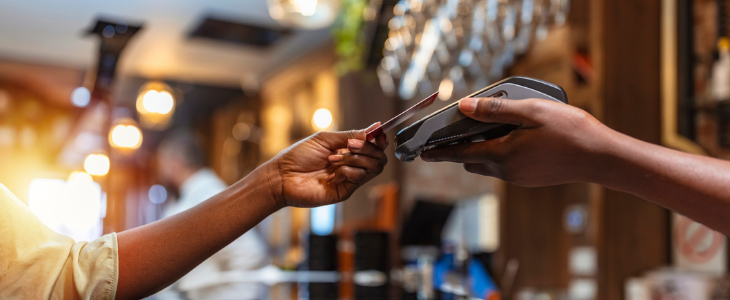
Credit cards still stagnant as the humble debit card’s popularity improves
Credit card use is still below its pre-pandemic levels, while debit cards are seeing somewhat of a resurgence in 2021.
The latest Reserve Bank (RBA) credit and debit card data for March 2021 reflects how these cards have been used in the 12 months since the pandemic truly impacted Australians’ way of life.
According to the most recent data, the number of active accounts fell slightly from February to March to still be 7.25% below the March 2020 level (14.48 million accounts).
Debit cards meanwhile are 3.5% above pre-pandemic account numbers (35.28 million), with a minor monthly increase in the number of cards on issue.
That doesn’t mean people aren’t using their credit cards – far from it.
The number of month-on-month credit card purchases increased by 3.25% (more than 268 million), and the value of these purchases rose by almost 5.5%.
Since March 2020, the number of credit card purchases is up by more than 9%.
But these figures are nothing compared to the debit card.
Over the past 12 months, debit cards have seen a more than 20% rise in the number of purchases to 796 million in a month, and the value of these purchases has increased by 19.3% to roughly $36.3 billion.
Credit card use plunged during the COVID-19 pandemic, particularly among younger Australians, and many got busy wiping off their credit card debt during lockdowns, with some help from stimulus payments, super withdrawals and increased savings.
So while credit cards are still being used, it would seem they’re being used more conservatively:
- Balances accruing interest (i.e. debt) fell slightly over the month, and is now 26.3% below its pre-pandemic levels
- Total balances on credit cards rose by 0.6% in March but are still down more than 16% over 12 months
- The average balance accruing interest is about $1,550 dollars ($2,908 for total balances)
- And even the number and value of cash advances (which tend to charge high interest rates) are down 7.5% and 15.7% respectively
The aversion to the higher interest charges on credit cards seems to be one reason for their decline compared to debit cards.
Payments expert Grant Halverson told Savings.com.au last month that “out of date” product is another reason.
“Credit card debit, which is now 1.3% of all consumer debt, is fading badly because the major banks … are still hooked on airline point programs – which only attract transactors not revolvers – while they push mortgages as the major debt vehicle – which is working,” he said.
“Debit has been growing double digits since 2009 – that’s picking up consumer spend and debt is now split across a range of lending.”
Travel Spending is Back for Credit Card Users
Points chasers and travel enthusiasts seem to have reacted positively to news of the New Zealand travel bubble and interstate travel incentives, according to Citi’s April Credit Card Index.
Credit card spending in April was 35% higher compared to April last year when spending was at its lowest point in years due to the pandemic.
Much of this growth has been driven by increased travel spending, particularly when it comes to rewards points redemption, which was halted for most of last year.
Head of Credit Cards and Loans at Citi, Choong Yu Lum, said rewards redemption on Citi cards rose 6% in April.
“Resurging after a year’s lull are travel and airline categories: general travel and experience redemption was up 10%, and Velocity points up 14%,” Mr Lum said.
“It is another strong indication that our Trans-Tasman bubble is working when it comes to stimulating spend in tourism.
“Additionally, we expect that increased domestic travel has contributed to this spike.
“The announcement of the New Zealand travel bubble early in the month has propelled airline spend…and (we) anticipate this will increase over the next few months as more families are reunited with their loved ones from across the Tasman.”
Article Source: savings.com.au

Study pinpoints two key areas that banks can improve on
Australian banks are not delivering appropriate omnichannel customer service and struggle to keep up with changing approaches to customer loyalty, according to new research.
The study, conducted by software company Pegasystems and research group Omnipoll, found that poor omnichannel customer service results in more than half (54 per cent) of all customer interactions having at least one issue.
Customers’ top challenges included being forced to call or visit a branch after failing to complete an action online (36 per cent), waiting longer than expected for service in a branch or on the phone (28 per cent) and being transferred from one agent to another (25 per cent).
On the positive side, the study found signs of improved customer service from Australia’s banks over the past two years. The industry had an 86 per cent customer satisfaction average across Australia. This is more than energy/utilities providers (74 per cent), telecommunications (78 per cent) and general insurance (80 per cent).
According to the survey of 1,221 Australians aged over 18, banking customers say the number one driver of satisfaction is easy interaction with their bank.
It found that “digital” customers – those that travel cashless, regularly use online banking and prefer to pay with their phone – are the most satisfied with their banks and more likely to recommend them to other people, but they are also the least loyal.
Indeed, 49 per cent of “digitals” have considered switching banks in the past six months, compared to 36 per cent of “traditional”, the most loyal group, who are also the least satisfied and least likely to recommend their bank.
The researchers attribute this lack of satisfaction among “traditionals” to poor omnichannel service through the pandemic, particularly with branches closing.
The traditional segment – mainly comprising customers over 50 years old – also rated their banks poorly on proactively helping them with money management. Despite this, traditionals still show the most loyalty and longevity, with six in 10 traditionals having been with their bank for more than 15 years.
The researchers attribute the growing lack of loyalty in the digital segment to multiple reasons. Firstly, only 32 per cent of all customers feel their bank is good at rewarding loyalty, while only 38 per cent feel they are given the best possible prices or rates.
Digital customers are also much more likely to have products across multiple banks, which significantly reduces switching challenges. Therefore, if digital customers are unhappy with their current provider, switching is a much simpler process than it would be for traditional customers.
“While banks are doing well to achieve high customer satisfaction, there is work to be done in delivering seamless omnichannel customer journeys and providing proactive customer service,” says Jonathan Tanner, senior director, industry principal financial services and insurance APAC, at Pegasystems.
“Given the level of first-party data banks have on their customers, there are plenty of opportunities to enhance customer relationships and improve customer journeys by providing more personalised service.”
Tanner adds: “Traditionals, in particular, are looking for more personalised, proactive service. As banks continue to close branches, they will need to support traditional customers in transitioning to digital banking to ensure they don’t feel left behind.”
“As this research shows, loyalty is no longer an accurate indicator of customer satisfaction, especially for digital customers who are more often on the lookout for better deals and service and more willing to change providers. This means customer relationships and seamless customer journeys will be pivotal to banking providers’ long-term success.”
Article Source: rfigroup.com

Top Five Banking Predictions for 2022
Top Five Banking Predictions for 2022
Keen to keep pace with the impact of recent global events and an accelerated digital shift, how are financial institutions, consumers and SMEs adapting their behaviours in coming months? RFI Global’s infographic explores our top predictions for 2022.





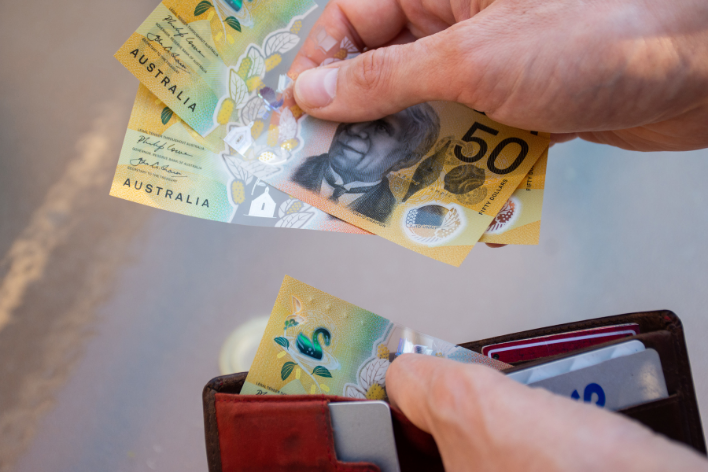
A proliferation of payment options has reduced our reliance on cash.
A proliferation of payment options has reduced our reliance on cash.
The million dollar question is: are we ever going back? A proliferation of digital payment methods and the Covid-19 pandemic has prompted a radical change in the way consumers use and keep cash in the past year.
According to research by the Australian Competition and Consumer Commission (ACCC), for the year ending June 2020, the number of cash withdrawals dropped by 19 per cent to 625.6 million compared to the prior year. This follows declines that have been occurring since 2013, with ATM withdrawals dropping by 30 per cent in the past five years.
There are more than 27,000 ATMs in Australia, which performed more than 423 million transactions in the year ending October 2020. Reserve Bank of Australia figures reveal we collectively withdrew $110.3 billion.
It might sound substantial, but the fact is that cash withdrawals from ATMs have been in decline since 2012, leading to the Big 4 banks to reduce the number of ATMs across the country.
The displacement of cash as a method of payment has been occurring ever since the first payment was made by a card back in the 1974. Today cash usage is down across all age, household income and transaction size categories.
1974. Today cash usage is down across all age, household income and transaction size categories.
Analysis by the Reserve Bank of Australia (RBA) shows that the amassing of $50 and $100 notes reached ‘unprecedented’ levels during Covid-19 lockdowns last year. This occurred at the same time as cash being used much less for everyday transactions, with suggestions early on that the virus could live on bank notes for many days.
Much of the recent fall has been due to the impact of Covid-19, with the number of cash withdrawals between April to June 2020 falling 46.7 per cent to 98.3 million from 184.6 million over the same period in 2019.
Right now, there are about $90 billion notes on issue, and $4 billion coins circulating in the economy. But the cost to the economy of using cash is a function of the cost of producing notes and coins, the amount of cash in circulation, and how often it is used.
The reasons for using cash differs significantly between low and high users. For low cash users, merchants’ lack of card acceptance drives them to use cash; whereas heavy cash users find it helps them to budget to use cash – because you can only use what you carry.
A big driver here towards cards in favour of cash, of course, is the acceleration of online shopping post-pandemic, which in turn has had major ramifications on banking infrastructure.
Ultimately, this helps to make the digital wallet ecosystem more attractive to merchants and the shift to cashless more likely to be permanent.

Biometrics to secure over $3 trillion in mobile payments by 2025
Biometrics to secure over $3 trillion in mobile payments by 2025
A new study has found that biometrics will authenticate over $3 trillion of payment transactions in 2025, from just $404 billion in 2020.
A new study has found that biometrics will authenticate over $3 trillion of payment transactions in 2025, from just $404 billion in 2020.
The report found that biometrics, including fingerprint, iris, voice and facial recognition are becoming critical to offering compelling app experiences, as mobile payments begin to take off in the payments landscape.
The extraordinary growth of over 650% will be fuelled by increased use of OEM Pays (such as Apple Pay and Samsung Pay), for both remote and in-store payments, as these applications have already embraced biometric authentication methods.
The research recommends that all payment apps take notice of biometrics and build the most seamless user experience leveraging biometric capabilities, or risk losing out to more secure OEM Pay alternatives.

Biometric usage lagging behind hardware adoption
The research found that although biometric capabilities will reach 95% of smartphones globally by 2025, only 35% of these smartphones will be used for making biometric payments in e-commerce in the same year.
The research identified that stored card-on-file payments without biometric security remain common in e-commerce, and that it will require significant efforts by stakeholders to transition spend to biometrically-secured methods.
“While biometrics are now an established part of the ecosystem, payments and e-commerce apps have not kept pace with the rate of innovation,” explains Research co-author Susan Morrow. “Merchants must adopt biometric capabilities rapidly and educate users to best secure the increasingly massive e-commerce market.”
Contactless payments driving biometrics use
The research also found that contactless mobile payments are a major driver of increased biometrics use, with the number of contactless mobile transactions secured by biometrics increasing by over 520% between 2020 and 2025.
The research identified contactless cards as the main threat, as they do not require the extra verification step, meaning that payment vendors need to incentivise wallet use to drive greater adoption of biometrics.
Source: Alex Rolfe – Payments Cards and Mobile 2nd February 2021.
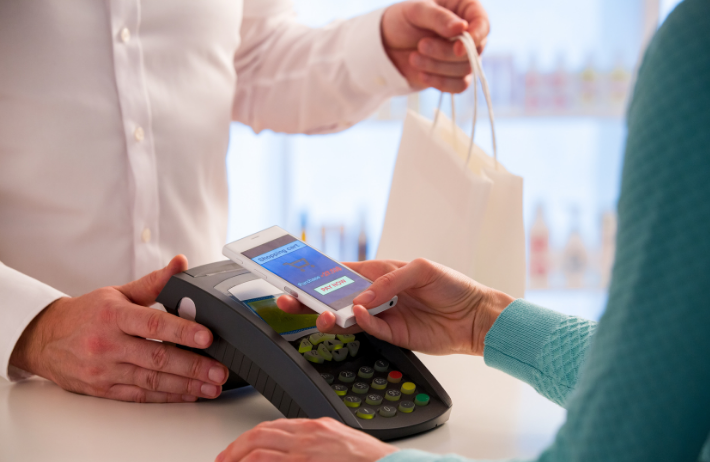
Stay COVID-safe with contactless giving | Indue Digital Gift Card
Stay COVID-safe with Contactless Giving
Contactless payment methods have never been more important. The ‘tap-and-pay’ approach to purchasing everyday essentials has well and truly become the norm, with the global pandemic forcing us to rethink our daily movements, including how we choose to pay.
The Rise of Contactless Payments
The rise of contactless payments can be seen right across the sector, made even more accessible following the temporary increase of PIN limits for contactless payments from $100 to $200 to reduce the need for physical contact with payment terminals, a move led by the Australian Payments Network (AusPayNet)[1].
This sentiment can also be translated to the gift card space. What has traditionally been a somewhat ‘hands-on’ process — from purchasing in-store to the act of giving itself — gift cards are now turning completely digital and Indue are the first in Australia to utilise the Visa network to make this happen.
It’s a move that’s in line with shifts in consumer behaviour. A 2019 survey by Roy Morgan of more than 50,000 consumers revealed 72 per cent of Australians are embracing digital payment solutions and mobile payment wallets in lieu of more traditional physical payment methods while shopping[2], and this has only been amplified as we tackle the global pandemic.
New Contactless Gift Card
Indue Chief Commercial Officer Dave Hemingway said Indue’s new contactless digital gift card offering further embeds the business’ payment expertise in the retail sector, setting a new benchmark in retail technology.
“Consumers expect fast, convenient and secure payments, and Indue is proud to redefine the boundaries to create an exciting, new product that we’re certain will benefit retailers and consumers across the country, even more so from a COVID-safe perspective,” Dave said.
“Building on our 20-year partnership with Visa, together we’ve created an entirely new product allowing major retailers to utilise a digital gift card that is universally accepted without requiring point-of-sale integration, paving the way for future advancements in this sector.”
With the widespread impacts of COVID-19 affecting several industries across the country, technology will play a key role in helping businesses bounce back. There has never been a more crucial time for retailers in particular to consider digital gift cards as a way to secure a solid consumer base and boost sales through a convenient, safe and seamless purchase journey.
In this increasingly contactless environment, the rise of innovative, digital solutions that not only streamline gift giving and receiving, but protect our overall health, will no doubt become a necessity as we continue to navigate the ‘new normal’.
Find out more about Indue’s innovative gift card offering here, or contact us today.
References
[1] https://www.auspaynet.com.au/insights/Media-Release/ContactlessLimitsCOVID-19
[2] https://www.finder.com.au/australians-digital-payments-roy-morgan-survey#:~:text=A%20new%20survey%20from%20Roy,Zip%20and%20mobile%20payment%20wallets.&text=Bill%20payment%20services%20were%20the,in%20the%20past%2012%20months.

Digital gift card convenience | A new way to give
A new digital way to give
Contactless convenience is the ultimate win for consumers when it comes to Indue’s new digital gift card offering.
Innovation in the Australian Gift Card Market
The Australian gift card market is valued at up to $2.5 billion annually[1], making it the most popular gift given in Australia. Market research has shown that while gift givers would prefer to gift something physical to convey thought and meaning, recipients generally prefer to receive digital gift cards for the convenience factor. Indue has tapped into this sentiment, creating a multi-merchant digital gift card solution, providing multiple options for the recipient to choose where they spend.
Just six months in the making in partnership with Visa, the Indue digital gift card provides the same level of security and convenience customers know and trust when they tap-and-pay on their mobile phone or wearable device. Lost or forgotten cards are a thing of the past with a balance displayed in real time, enabling recipients to check their balance on the go and removing the need to attempt multiple transactions to spend the remaining value.
Digital Gift Card Convenience
Consumers want the convenience they’ve come to expect from using their smart device for transactions, so it’s only natural that digital gift cards provide a better customer experience overall.
The digital gift card also offers added flexibility when it comes to purchasing them online, particularly around peak holiday periods.
“Digital gift cards extend the buying window at the busiest times of the year, in particular the lead up to Christmas,” said Indue Chief Commercial Officer, Dave Hemingway.
“When people are buying plastic gift cards online, that stops at around 19 December because purchasers are concerned they won’t arrive in time. Consumers now have the ability to buy a digital gift card online on Christmas Eve, with an almost instant digital delivery to the recipient.”
Find out more about Indue’s innovative gift card offering here, or contact us today.
References
[1] https://treasury.gov.au/publication/gift-cards-in-the-australian-market-report-2/gift-cards-in-the-australian-market-report/part-ii-the-australian-gift-card-market

New digital gift card a win for retailers
Indue’s new digital gift card a win for retailers
Indue, in partnership with Visa, is transforming the gift card experience for Australian retailers and consumers with its innovative new offer.
A convenient, contactless payment option
Paving the way for future advancements in the sector, the new digital gift card allows major retailers to offer a digital gift card that is universally accepted, without requiring point-of-sale integration.
In addition to offering a convenient, contactless payment option for consumers, the product also provides the ability to capture consumer data to generate targeted engagement. Recipients of the digital gift card are required to download the retailer’s app in order to provision their digital gift card into Apple Pay or Google Pay, creating an opportunity to gather purchasing metrics, serve up additional offers to consumers and link in to the broader shopping experience.
Enhancing Consumer Engagement
“There’s no ability to connect with a consumer when they use a plastic gift card — it’s an anonymous transaction. Our digital gift card technology, which integrates seamlessly with retailers’ existing apps, encourages tighter engagement,” said Indue Chief Commercial Officer, Dave Hemingway.
“Our mission is to ensure the millions of Australians who access their money through our clients’ companies have access to market-leading payment products, and we’re thrilled to have delivered once again with our digital gift card.”
Operating costs for retailers who offer digital gift cards are also lower, removing the need to pay for manufacturing and distribution. Expiry dates for many gift cards need to be printed on the card at the time of manufacture, which could result in stock issues if the cards are unable to be sold within a set period, whereas Indue’s digital gift cards generate an expiry date at the point of purchase.
Importantly, Indue’s digital gift card is flexible in its deployment, providing both B2C and B2B distribution solutions.
“Digital gift cards don’t necessarily need to be distributed via e-commerce. For example, we’ve had enquiries around digital gift cards to distribute to staff as part of a loyalty program, so there are a range of different distribution models that we can harness,” Dave said.
Find out more about Indue’s innovative gift card offering here, or contact us today.

5 Trends influencing payments by CEO Derek Weatherley
The top five payment trends influencing 2020
The digitisation of payments, changes in ecommerce and acceleration of mobile wallet adoption are global payments trends in 2020 challenging the industry to keep pace. These trends are not only forcing businesses to change the way they operate, but are also putting data security at the forefront of business strategy.
With the future of payments quickly coming into focus — thanks in no small part to the impact of COVID-19 — Indue CEO Derek Weatherley shares his insights on the top five payment trends influencing 2020.
- The ecommerce experience and embracing the evolution
Even prior to the COVID-19 pandemic, ecommerce was expected to continue to grow rapidly in 2020. But restrictions and public space shutdowns have significantly changed consumer behaviour, with a 29 per cent increase in ecommerce spending locally month-on-month since lockdowns began in March1. On the other hand, physical transactions have decreased and people are using less cash — a longer-term trend accelerated by the global pandemic as some businesses discourage the use of cash.
Helping drive this trend is a population seeking more flexible and convenient ways to pay. Combine this with confidence in stronger digital security and a willingness within the retail sector to embrace technological change, Australia is starting to see mobile payments take off. In 2019, The Reserve Bank of Australia reported 83 per cent of point-of-sale card transactions were contactless payments, signifying a rise of almost 20 per cent in three years2. COVID-19 is only adding to this rise with the payments industry temporarily increasing the contactless card PIN limit from $100 to $200 to minimise physical contact with the payment terminal and help reduce the risk of COVID-19 transmission.
One trend to keep a close eye on is the digital wallet. Roy Morgan’s latest Digital Payments Report revealed that digital wallets such as Apple Pay, Google Pay and Samsung Pay are being used by roughly one in 10 Australians (9.8 per cent) — up from 6.8 per cent a year ago3. This upward trend will continue, but the mobile wallet race hasn’t fully played out just yet as the industry looks to cater for all the different use cases.
One thing is clear — the payment industry will continue to evolve to meet the needs of merchants as consumers demand improvements to the overall ecommerce and contactless experience.
- Congestion, Competition and the Customer Dollar
It’s a busy time for payment systems operators, with heightened conversation taking place across payment schemes in the industry. We’ve also seen in recent times a significant transformation of the base-level clearing and settlement capabilities, causing disruption for many in this space and providing future innovative payment solutions.
The high level and pace of change is causing congestion and headaches for financial institutions and payment providers. As older forms of payment are migrated, schemes are coming into competition with each other, creating congestion and ultimately higher costs for consumers.
This will likely settle in the next three to five years as the industry settles on its future scale approaches to utility payment processing, but the medium-term landscape remains challenging and costly.
Understanding what’s next in payment industry platforms comes down to understanding the value proposition in the eyes of consumers and merchants and their respective appetite to pay. We expect to see competition between providers of closed and open payment platforms increase, as they contest for a larger slice of their customer dollars and loyalty4.
- Money moves fast and attacks are evolving
Data security in the world of payments has never been more crucial and with innovation comes security issues as payment products and services evolve. The speed of transactions have increased through advancements like New Payments Platform (NPP) real-time payments, and we are exposed to significantly larger and more valuable data footprints online, which all contribute to a heightened risk of fraud. By investing in sophisticated machine learning payment technology, Indue now has the capacity to draw from a much larger pool of data and undertake significantly more sophisticated real time analysis to detect trends that benefit — and protect — each individual client.
Indue’s Orion Financial Crimes solution integrates human and artificial intelligence (AI) with machine learning algorithms to deliver a 24/7 fraud monitoring solution. This solution provides a broad gambit of services, including real-time fraud and anti-money laundering monitoring across all payment channels. This is a significant shift in how financial institutions trade on trust, and therefore need to put reputation and security at the forefront of their business priorities. Without robust data security measures, businesses run the risk of damaging their brand and making consumers feel uncertain about the safety and security of their accounts.
We have transformed our financial crimes services and continue to invest in leading-edge payment technology to better monitor trends and ultimately protect our customers from fraud. Assurance of identity in a virtual world is another key area of focus in an increasingly digitised world and an area where we are assisting our customers to adapt to with ongoing innovation in this area.
- Less friction, more function
Product commoditisation will not only challenge business models, but shift the economic climate, especially in the banking and fintech sector. Digitisation and ease of payments have changed the way customers think, decreasing the value of traditional competitive differentiators in the process — payments are now instantaneous, simple and 24/7.
As consumers become more and more accustomed to these seamless transactions, it presents a challenge to providers who need to balance the cost of creating a frictionless experience and meeting consumer expectations. Expect to see structural shifts among the players operating in this environment as they look to drive revenue through new or enhanced customer experiences, and make use of data analytics to anticipate customers’ changing needs and expectations4.
- Wake up to new ways
COVID-19 has made embracing and adapting to the work-from-home environment a must for businesses. The shift has provided opportunities for businesses to expand their workforce and recruit talent from anywhere, as most payment organisations aren’t restricted by location.
Even before COVID-19, Indue embraced work from home and flexible working hours, revising the way we manage talent to reap the positive benefits of a geographically dispersed workforce and provide an increased work/life balance across the organisation.
The final word — what do these 2020 payments trends mean for our customers?
Our customers rightly focus their investment dollars on driving the top line, and leave the distraction of digitisation and changing payment rails to us to handle on their behalf. However, with continued evolution of the online world, it’s important that our customers sensibly invest in the modernisation of their platforms, particularly those platforms that make their customers lives easy. They don’t need to be on the leading edge, but do need to keep pace.
References
1 https://www.adnews.com.au/news/online-shopping-orders-have-increased-49-this-year
2 https://www.mobiletransaction.org/au/tap-and-go-trending-in-australia/
3 http://www.roymorgan.com/findings/8308-digital-payment-solutions-december-2019-202003100329
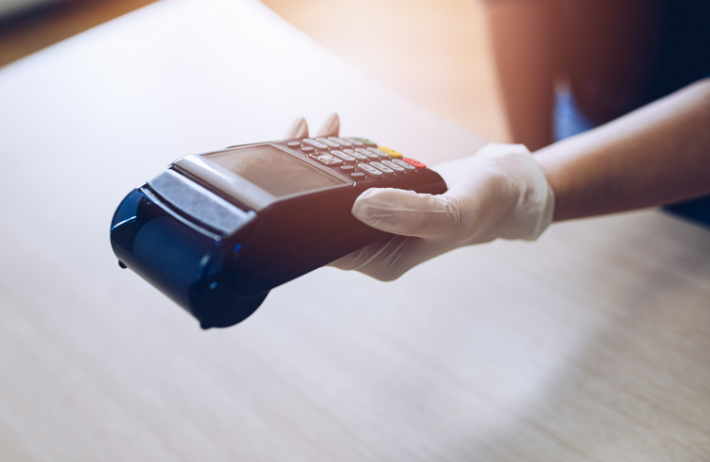
2020 Pandemic: How might it change the ways we pay?
2020 Pandemic: How might it change the ways we pay?
Although the total number of payments in the Australian market is currently suffering a severe decline, as economic activity is strongly curtailed, what might happen to the ways consumers pay after the 2020 pandemic? Guest writers, David Oierholm and Lance Blockley of The Initiatives Group, offer their view.
The COVID-19 2020 Pandemic is having an unprecedented impact on how we live and work. We are planning for the worst and hoping for something better. No matter how long it takes for the crisis to pass, 2020 will be a year that is not forgotten quickly.
It will undoubtedly be a period of change, some of which will alter the way we do things forever.
We are likely to wash our hands more frequently, and we will be much better at conducting remote meetings using platforms such as Zoom, Webex, Skype for Business, GoToMeetings, etc. Telemedicine will likely become more prevalent, as will the ability and propensity to work from home effectively.
We will be super-sensitised to microbes, and, given the economic impacts being experienced, we may be more concerned about the sustainability of the companies we buy things from, together perhaps with more conservative views regarding our ongoing employment and income. Indeed, the cross-border supply chains that have been constructed over the last 15+ years of globalisation have been shown to be a potential weakness (e.g. a key global production site of surgical masks being in Wuhan), so perhaps domestic manufacturing will get a boost everywhere and cross-border commercial transactions decline.
Although the total number of payments in the Australian market is currently suffering a severe decline, as economic activity is strongly curtailed, what might happen to the ways consumers pay? Not necessarily in the short term – although many merchants are now refusing to take cash, travel card issuance & usage has crashed, and cross-border payments (a key revenue source for the international schemes) are drying up. Rather, we are looking at the potential longer term residual impacts.
In The Initiatives Group white paper “The Changing Face of Consumer payments in Australia”, we identified that the way we pay takes a long time to change. It is all about trends, and long ones at that. The following graph was used to show how the ways we pay have changed over the past 15 years. The trends are clear – cash and cheques are on the decline, and fast becoming in the minority of transactions. Electronic payments continue to increase. Cards are now more than 60% of transactions, with the growth in debit cards far outstripping credit cards. It is now quite normal to pay for a morning coffee (currently only available as “take away”) using a card – not so long ago a $3.50 purchase would have been made with cash.
The trends are clear – cash and cheques are on the decline, and fast becoming in the minority of transactions. Electronic payments continue to increase. Cards are now more than 60% of transactions, with the growth in debit cards far outstripping credit cards. It is now quite normal to pay for a morning coffee (currently only available as “take away”) using a card – not so long ago a $3.50 purchase would have been made with cash.
What might happen to cash?
“Fed Plans Release of Clean Cash As Virus Spreads” (pymnts.com, March 22, 2020)
The decline in the use of cash will accelerate, along with an associated decline in ATM usage (noting that for every ATM withdrawal that does not happen, an additional 10-15 electronic transactions will be generated, mainly on debit cards).
 Cash carries bacteria 1 (no prior studies seem to have focused on viruses!). Both cash and bacteria travel fast. Even though it has been found that polymer notes, like those used in Australia, carry less bacteria than (absorptive) paper notes such as those in the USA and China, consumers and merchants alike will be less keen on handling cash, and more keen on using electronic payments. Indeed, the UK has just lifted the contactless limit from GBP30 to GBP45 to help further reduce the use of cash. More locally in Australia, one of your authors has found that cash is no longer accepted at the local Coles Supermarket, Harris Farm Markets and the golf club (which is closed for now anyway).
Cash carries bacteria 1 (no prior studies seem to have focused on viruses!). Both cash and bacteria travel fast. Even though it has been found that polymer notes, like those used in Australia, carry less bacteria than (absorptive) paper notes such as those in the USA and China, consumers and merchants alike will be less keen on handling cash, and more keen on using electronic payments. Indeed, the UK has just lifted the contactless limit from GBP30 to GBP45 to help further reduce the use of cash. More locally in Australia, one of your authors has found that cash is no longer accepted at the local Coles Supermarket, Harris Farm Markets and the golf club (which is closed for now anyway).
So, are plastic cards the answer?
Australians are the world leaders in the use of contactless open-loop payments, with well in excess of 90% of card present transactions being contactless. This means that, for transactions under $100, we don’t need to touch a terminal that somebody else has used or handed us. We also don’t have to hand our card over to a stranger. That’s good, right?
Well, maybe not… unfortunately there are studies, albeit in the USA, where contactless payments are still in their infancy, that have shown that cards “can be grimier than cold hard cash”.2
However, it still feels safer to use a card that only you have held than notes and coins that have gone through multiple hands, so plastic cards will quickly pick up transactions from cash.
How about other transactions that use the card rails?
Mobile Wallets
Despite the high ownership of smartphones and Australians’ love of contactless payments, until recently, the take up of mobile wallets such as Apple Pay, Google Pay and Samsung Pay (the “Pays”) has been slow. It may depend on your industry and your demographic, but The Initiatives Group has heard conflicting reports. Claims of 25% of POS transactions being handled via the Pays have been offset by merchant claims of far far lower percentages, hence we would suggest that the average across all contactless payments is still under 10%.
Regardless, the use is set to accelerate. Your phone may or may not be a great carrier of bacteria, but it is something you will touch anyway, so what’s the difference if you now use it for payments and avoid fiddling around with your wallet for a card.
Wearables
Whilst wearables are only another form factor for using the Pays, their use is likely to increase as an even more “contactless contactless” form of payment. Notwithstanding we believe that wearables, perhaps other than smart watches, will remain relatively niche.
In-app payments
In-app payments are likely to be a big winner from the COVID-19 crisis. Seamless payments will be the most contactless of contactless payments. Whilst in the short-term popular use cases such as Uber transport will take a significant hit, there will be many new use cases that become available earlier or even more popular – think of ordering home delivery (from supermarkets, for prepared food e.g. Menulog, Ubereats) and petrol stations (where something like the Caltex app avoids the need to enter the shopfront). We will be more ready to form new “safe” habits, and, if used frequently enough, these use cases will be habit forming, just as the adoption of contactless card payments was slow until Woolworths and Coles offered them (back in 2012).
We found the new 13cabs “No Touch Parcel Deliveries” of interest. Whilst no-touch may not be as big a deal from 2021, here is another reason to get into the habit of using in-app payments for taxi services. In the future will we see the groceries delivered paid within the 13cabs app, or the taxi delivery paid for within the Coles or Woolworths app?
Peer to peer payments
As handling cash becomes less popular, might we now see electronic peer to peer payments use accelerate. Perhaps this will provide stimulus to the use of PayID, Beem It and card-tocard systems. Although current social distancing and work-fromhome orders may well diminish the need to pay our friends and relations in the near term.
eCommerce card not present
In the short-term, eCommerce spend on travel and discretionary items has tanked, however online ordering of grocery goods and fresh foods is up globally. Discretionary spend, such as fashion, will recover once people are again allowed to physically interact. Grocery and fresh food ordering online will be a new habit – whether for home, work or locker delivery, or click and collect. Although it may not maintain at COVID-19 levels, this will likely fuel more rapid long term growth in eCommerce retail spend.
Monthly payments
The economic impact of potential (or actual) unemployment, of recession and of media noise about depression, will all make consumers more wary of both the sustainability of companies that they deal with and their own ability to pay in annual large lump sums. We predict this will lead to a preference for annual payments to be made monthly (already a trend before the crisis), and not necessarily by auto direct debit (as consumers may wish to retain control). In addition, this preference may lead to consumers demanding that they are not penalised with any surcharge for paying monthly.
Noting that, just as the decline in ATM use accelerates the volume of electronic payments, so too does monthly payment . . . 12 transactions rather than one.
New products
Adversity is often the mother of invention, so it is likely that we will see a range of new electronic payment products, use cases and services being created.
Opportunities only for the card rails?
An emphatic “No”. As noted above, online real-time payments over the NPP may be accelerated – whether by Osko, other overlay services or by ‘pay anyone’ (previously via direct entry) payments growing faster. The increased volumes allowing the NPP to become less expensive per transaction.
Perhaps a trend towards mobile phone payments will improve the use case for NPP payments on your phone at POS, enabled by QR codes? Notwithstanding, we do expect that there will be even more new overlay service activity that takes advantage of the NPP.
Conclusion – How might Covid 2020 Pandemic Change the Way We Pay?
The current COVID-19 crisis will see payment volumes drop sharply as economic activity stalls. Within the remaining payment activity, the mix of payments will change:
- The reduction in cash and ATM usage that has been occurring over many years will accelerate into a steep decline
- The cross-border usage of payment cards will drop to low levels
- Use of contactless card and mobile payments will rise
- Use of remote services/ordering, and with them the associated remote payments (eCommerce, in-app, other online), will increase
- A move to monthly payments.
Depending upon the length of the crisis, many of these changes will become habitual and are likely to outlast the short term impact of the virus – such that the retail payments mix in the Australian economy will be altered forevermore.
Disclaimer: The opinions expressed in this article are the author’s own and do not necessarily reflect the view of Indue. The Initiatives Group has advised participants in the payments market since the 1990’s – including issuers, acquirers, third-party processors, technology providers and associations. The Initiatives Group has a strong relationship with Indue, and can help participants in the payments sector generate more value from their markets and customers. To find out how, please get in touch.
Sources:
1 A Oxford University study in 2014 found that the average European banknote contained 26,000 bacteria which could be potentially harmful to a person’s health; and market research has found the majority of European consumers rank physical money as being more unhygienic than the hand rails on public transport
2 https://www.fastcompany.com/90480199/how-companies-can-support-their-employee-caregivers-duringthecovid-19-outbreak

Tokenisation – What is it and can it beat payment fraud?
Tokenisation – What is it and can it beat payment fraud?
Tokenisation seems to be one of the key buzzwords in the payment industry at the moment. However, what does this concept really mean and how does it benefit payments made today?
What is Tokenisation?
Tokenisation is a method of protecting sensitive data by replacing it with an algorithmically-generated number referred to as a ‘token’. In the payments world, tokenisation is commonly used to replace debit and credit card numbers in an attempt to prevent card fraud.
Under this form of tokenisation, a cardholder’s Primary Account Number (PAN) is replaced by a random number that is not linked to the card number prior to processing a transaction through the payments network. This process assists in mitigating the risk of exposing sensitive card data to unauthorised individuals or software that could potentially exploit the data by fraudulently duplicating the card details. It also prevents merchants from storing the PAN in databases, which are targets for hackers. Tokens cannot be decrypted or reverse-engineered. The only relationship between the original card number and its associated token number resides within the Token Service Provider.
What is a Token Service Provider?
A Token Service Provider (TSP) is a service provider that issues tokens, manages the lifecycle of tokens and stores the payment credentials associated with the tokens. TSPs can be an independent third party from the payment network or can be the actual card scheme (i.e. Visa, MasterCard, eftpos). TSPs must conform to strict security and privacy specifications defined by the global payment schemes and fall within the PCI-DSS compliance requirements.
Tokenisation in the Industry
Tokenisation takes many forms within the payments industry. One of the most prevalent uses of tokenisation is within the Mobile Payments space. When a cardholder provisions their payment card within an Apple or Google mobile wallet, the request is sent to the appropriate TSP to tokenise the card number. The token is then sent back to the mobile wallet for activation. The cardholder’s actual card number is never stored on the mobile device and as such cannot be extracted for misuse. All subsequent mobile transactions will use the token number as the payment credentials.
 Tokenisation for in-app purchases is also on the rise due to its convenience. Some in-app purchases leverage the mobile payment functionality whereby the token stored on the mobile wallet is used to make a purchase within the phone application. An example of this would include purchasing tickets on the Ticketek app and instead of inputting credit card details, the user is able to select the Apple Pay option, which references the credentials stored within the mobile wallet. Not only does this option provide an easy streamlined purchase journey, it also removes any sensitive data from the transaction.
Tokenisation for in-app purchases is also on the rise due to its convenience. Some in-app purchases leverage the mobile payment functionality whereby the token stored on the mobile wallet is used to make a purchase within the phone application. An example of this would include purchasing tickets on the Ticketek app and instead of inputting credit card details, the user is able to select the Apple Pay option, which references the credentials stored within the mobile wallet. Not only does this option provide an easy streamlined purchase journey, it also removes any sensitive data from the transaction.
Tokenisation for card-on-file online purchases is also becoming more common given the recent occurrences of global data breaches. Wawa, a popular convenience store chain in the United States, confirmed in late 2019 the discovery of malware on their payment processing servers. The malware captured credit and debit card numbers, cardholder names and expiration dates. Card-on-file tokenisation protects a cardholder’s card credentials stored at online merchants with whom the cardholder frequently make purchases. Netflix holds the card credentials of all its customers for the purpose of charging the monthly subscription fees. The streaming service provider has recently undertaken a significant exercise of tokenising as much of its database as possible as a means to mitigate the risk of data breaches. As more online merchants migrate to tokenisation, the prevalence of card data breaches will hopefully decrease as well. Given that a new unique token is generated for each retailer, a security breach at one retailer will not compromise the security of the token data at another retailer.
Payment Account Reference – Providing a holistic view
Although the use of tokenisation enhances the security of digital payments, it also presents a challenge. If a cardholder’s card credentials are tokenised for use within Google Pay on an android phone, Apple Pay for an iPad and Netflix for monthly subscription payments, it becomes a one to many relationship. One single PAN is now linked to several tokens across different systems and platforms.
As only the TSP has the original data linking the PAN to the multiple tokens, the lack of visibility makes it difficult for other parties such as merchants to have a consolidated view of all transactions performed by the cardholder and subsequently provide value-add and compliance services. An example of this is the provision of fraud and anti-money laundering monitoring services. To provide the most effective service, there is a need to identify transactions on an aggregate card level to better assess customer behaviour and payment trends.
As a means to provide a consolidated view, some card schemes have introduced the use of a Payment Account Reference (PAR). According to a recent white paper published by EMVCo, a global entity facilitating worldwide interoperability of secure payment transactions, a PAR is a ‘non-financial reference assigned to each unique PAN and used to link a Payment Account represented by that PAN to affiliated Payment Tokens’. PAR is passed in the transaction message to the merchant so that they can reference this field when performing customer level analysis.
EMVCo affirms that this is a long term solution that will solve the issue by linking together disparate card-based and token-based transactions without compromising on security. Although this is the recommendation of EMVCo, it is the responsibility of the card payment schemes to adopt this concept and implement it into their respective payment ecosystems. eftpos is introducing support for PAR in the near future.
Resources:

Insight: The changing face of consumer payments in Australia
Insight: The changing face of consumer payments in Australia
Our guest writer, David Oierholm, Director of The Initiatives Group, sheds light on the changes and trends of consumer payments in Australia.
The ways in which consumer payments in Australia are made is often likened to a train system comprised of the “rails” that carry the carriages (the payment systems), and the “carriages” that carry the passengers (the individual payments).
The media will have us believe that the payments landscape in Australia is constantly and rapidly changing. To an extent this is correct – but this is all about new “carriages” rather than “rails”.
Furthermore, simply because there are new ways to pay on offer, it does not mean that we all immediately change the way we pay. For example, it took well over 5 years for both BPAY and (much later) contactless card payments to become mainstream.
In Australia, there has only been one new set of rails introduced in the past 25 years (The New Payments Platform (NPP), 2018)
The Way We Pay
It is about trends, and long-term ones at that. The following graph shows how the ways we pay (our use of the rails) have changed over the past 16 years, exhibiting slow movements and not, as many media commentators would suggest, overnight leaps.

The trends are clear – cash (as proxied by ATM withdrawals) and cheque usage are on the decline, and fast becoming the minority of transactions. Electronic payments continue to increase. Cards now account for more than 50% of all payment transactions, with the growth in debit card activity far outstripping credit card since 2007. It is now quite normal to pay for a morning coffee using a card – not so long ago a $3.50 purchase would have been made with cash.
Will cash and cheques ever completely disappear? It is more likely that cheques will disappear, but only when the industry and/or regulator set a termination date – otherwise someone, somewhere will keep using them. However, the ability to access and use cash is considered critical for members of society who may be unbanked, and for remote residents where electronic payments may either be unavailable or inconsistent. Even in those economies closest to being cashless, such as Sweden, there are government requirements for the economy not to become cashless – at least not until no one is left behind or disenfranchised.
In 2019, the San Francisco Board of Supervisors passed a law requiring that all bricks and mortar retail businesses must accept cash – this even includes the Amazon Go stores (more about them later). This move is to make sure that the city’s poorest residents are not shut out of access to basic goods and services. Whereas “cash not accepted” signs are common in shops in Sweden.
The Rails
The rails for electronic payments in Australia include the card rails (Visa, Mastercard, Amex, eftpos), the rails for direct entry and direct debit payments known as BECS (Bulk Electronic Payment System), the real-time payments rails operated by New Payment Platform Australia (NPP) and the international bank to bank transfer rails (SWIFT). The only one of these sets of rails that has been introduced within the last 25 years is the NPP, launched last year.
(Source: The Initiatives Group)
The Carriages
What runs on the rails is where the new action has been, as a plethora of “veneers” have been placed on top of the payment rails, giving the perception that the movement of money has changed. What has changed, and greatly, is the consumer interface, which has become more convenient, simple to use, frictionless and seamless. But, as noted earlier, just because a new way to pay is being offered there is no guarantee that it will be used.
Mobile Wallets (Mobile Payments)
Mobile wallets such as Apple Pay, Google Pay and Samsung Pay, otherwise known as “The Pays”, have arguably received more media headlines than any other payments related topic over the past few years. Despite this, it is estimated that they represent fewer than 5% of card present transactions, albeit that there now seems to be some acceleration in the adoption rate.
Requiring a credit or debit card to fund a transaction, The Pays operate on the Visa, Mastercard, American Express and, to a lesser extent, the eftpos rails. They have been offered in Australia since 2015 when Apple Pay was launched with Amex.
Even though some would describe it as simply a new “form factor” – a contactless payment (now over 90% of card present transactions) using a phone rather than a plastic card – the rollout through the payments industry has been slow. A popular hypothesis is that using your phone currently offers little benefit over using a plastic card – that is, there is no value added.
In addition, there has been significant reticence amongst the major banks to fund the fees payable to Apple Pay, which also comes with the limitation of no other application being able to access the NFC interface on the iPhone. However, as of today the only major Australian bank that does not offer Apple Pay (considered the vanguard of The Pays) is Westpac, so it is felt that the current low usage rates will increase to more significant levels over the next few years, assisted by use on mass transit.
A different type of mobile wallet where you can “pre-fund” your account prior to purchase (or link to a “top up” source of funds) is particularly popular in China, and increasingly so throughout Asia. AliPay and WeChat Pay both from China are prime examples.
When making purchases, these systems run on their own sets of rails with the transaction driven by a QR code interface (overcoming Apple’s NFC quarantine). This has permitted significant growth in electronic payment acceptance due to the simple and low cost set up for the payee. However, to fund the account, money is transferred from the user’s card or bank account.
This means the funding uses existing payment rails. To date the use of QR codes in payments in Australia has primarily been limited to visiting Chinese tourists. Australians are already well served by NFC contactless payments, so, whilst there may be more value-adding capability within a QR code, there is little incentive for consumers to change.
Another popular wallet, although not so much in mobile format (at least not in Australia), is PayPal. Created as a payment wallet to make secure online transactions, the PayPal wallet can be instantly funded by a credit or debit account, or pre-funded. An interesting contrast is that in the US keeping funds in a PayPal wallet is popular, whereas in Australia it is not.
In-app Payments or “payments in the background”
Popularised by the success of the Uber rideshare app and the “just get out of the car at your destination and walk away” payment experience, in-app payments are the topic of a separate whitepaper published by The Initiatives Group.
Sometimes criticised for making it too easy for consumers to overspend as they do not have a “transaction moment” to reconsider their purchase, in-app payments are growing even faster than e-commerce. Prime examples include Uber – familiar to most of us; Grab, which dominates carshare in South East Asia, and which is now promoting its payment service in its own right as “GrabPay”; and the Hey You (Beat the Q) café pre-order and payment aggregator app.
In the USA, Starbucks is prolific enough to have its own pre-order and payment app, which accounts for a significant proportion of their sales and is integrated with the Starbucks Loyalty program. Further loyalty integrations are underway. For example, in the USA you can use American Express Membership Rewards points to pay for your Uber ride. Amazon is taking the in-app, seamless shopping and payment experience to the nth degree, (possibly out of the budgetary capabilities of most retailers) with its Amazon Go “no lines, no checkout” concept stores, it is extreme but an insight into what is already possible!
In Australia, Woolworths is currently trialling “Scan & Go” with selected Woolworths Rewards loyalty members in Sydney – it is a variation on Amazon Go, where shoppers scan items when they take them from the shelf and then just tap off when leaving the store. This is important, as Woolworths and Coles are able to move the market: it was really not until they adopted the NFC technology that contactless payments became commonplace in Australia.
The Form Factor
Many innovations on the existing payment rails are actually changes in the form factor. As noted earlier, mobile payments are, for the most part today, simply the ability to use your phone to make a contactless card payment, rather than use the physical card itself.
Other new form factors include smart watches, including the Apple watch, Samsung Gear watches, as well as Garmin and Fitbit with Garmin Pay and Fitbit Pay respectively. Similarly, there are wrist bands and tabs attached to watch bands, even sunglasses and jewellery, such as the Bankwest Halo Payment rings. Current opinion is that these “wearables” will become popular, but amongst niche groups rather than the general population – for example waterproof bands and rings for swimmers, surfers, runners and cyclists.
BPAY and Pay Anyone
BPAY and Pay Anyone (Direct Credit on internet banking or a banking app) are payment methods that use the BECS Direct Entry system. Both allow for bank account to bank account transfers five days a week (excluding Public Holidays), with banks transferring funds 5 times per day (but not necessarily posting them to accounts that frequently).
Reliable, secure and low cost, however it is possible that a transfer can take some time to occur or appear in the receiving account – if the transfer is made late on Friday afternoon and is to a bank that is not posting intra-day settlements it may not be until the following Tuesday that the funds appear in the recipient’s account.
Whilst BPAY volume continues to grow, BPAY now somewhat competes with itself as the provider of the first “overlay” service “Osko” for the NPP, which allows real time payments between consumers and businesses via BSB and account number or with a registered PayID (mobile number, email address or ABN) linked to their bank account. Further, a number of Financial Institutions have and are moving their Pay Anyone / Direct Credit transactions onto the NPP rails, instead of using BECS.
P2P (peer-to peer) Payments
Particularly popular in geographies as diverse as the USA and China (perhaps due to the antiquated and previously limited payment systems available), P2P payments allow instant payments between consumers – splitting the bar tab, paying your share of the rent, getting money to the kids quickly, etc.
Venmo (now owned by PayPal) in the USA and WeChat Pay in China are prime examples. Both allow instant payments between other Venmo or WeChat Pay users from a pre-funded wallet. Perhaps they could be considered alternative rails, however, funding still comes from the existing rails transfer methods as these are linked to accounts.
In Australia, BeemIt allows P2P payments between BeemIt users, requiring only a Visa or Mastercard debit card for registration. Interestingly, BeemIt accesses bank accounts by using Visa and Mastercard for the authorisation messaging, then uses the eftpos rails to achieve the instant funds transfer.
As with many new ways to pay, BeemIt has not (yet) become popular in Australia as it has yet to gain sufficient penetration or ubiquity, and perhaps does not solve a significant problem that Australian consumers have (given the various other ways that they have to pay).
Real-time Payments
The establishment of real time payments platforms, moving and posting money between accounts 24×7, such as Australia’s NPP, is a major global trend. The UK has had “Faster Payments” and Singapore “FAST” for some time. More recently, Malaysia “DuitNow” and TCH (“The Clearing House”) in the USA have introduced real time payment platforms.
The NPP was launched in February 2018, the first new payment rails in Australia for 25 years (the prior launch was BECS in 1993). The NPP is an initiative that was primarily driven by the Reserve Bank of Australia, following its review of innovation in payments, and is co-owned by 13 banking organisations. It allows for real time payments between bank accounts.
 To date, it has been held back by a somewhat uncoordinated introduction through the banking system. Whilst over 2 million PayID’s have been registered, use of the Osko payment “overlay service” has been relatively limited. This is likely to change once all banks deliver the range of features available, more entities register PayID, and business applications such as “Request to Pay” and a central consent management platform are delivered (effectively allowing Direct Debit transactions to be introduced by the NPP).
To date, it has been held back by a somewhat uncoordinated introduction through the banking system. Whilst over 2 million PayID’s have been registered, use of the Osko payment “overlay service” has been relatively limited. This is likely to change once all banks deliver the range of features available, more entities register PayID, and business applications such as “Request to Pay” and a central consent management platform are delivered (effectively allowing Direct Debit transactions to be introduced by the NPP).
Even Sweden’s “Swish” success story has taken almost 7 years since its establishment in 2012 to reach a total of 1 billion transactions through the system.
Use cases range from instant P2P payments, to real time payment of employee wages, superannuation, even to the ability to safely buy/sell a used car privately on the weekend without the need for cash transfers or bank cheques.
(Image Source: Osko.com.au)
Real-time / Faster Cross Border Payments
Cross border account to account payments have primarily been the domain of Swift and its 165 member banks. Even if the origin or destination banks are not members, the 165 banks can act as “correspondent” banks to route funds into the recipient country and currency, then onto the recipient bank. It is reliable, but can be slow, opaque and relatively expensive. The Swift rails also enable currency transfer services such as Western Union.
Faced with the emerging faster cross border payment challengers, such as crypto currencies, Ripple, Visa B2B Connect, and Visa and Mastercard acquiring FX transfer platforms, Swift has been developing faster, lower cost transfer products to enhance its existing rails. Swift GPI (Global Payment Innovation) is now conducting faster cross border payment trials, and is poised for rollout network wide.
Swift, which also provides the distributed switching platform for Australia’s NPP, is also testing its involvement in integrating the different real-time payments platforms between countries.
Thought too slow and expensive (today) for domestic payments, cryptocurrencies and distributed ledger technology is of interest for the future of cross border payments, although there is a long way to go. For example, Bitcoin transactions can occur at between 10-20 transactions a second (versus Visa at up to 56,000 per second), and crypto currencies are infamous for the volatility of their value in fiat.
However, the announcement in June 2019 of the Libra Foundation, with its bundled currency backed blockchain based “stablecoin”, and the Facebook developed Calibra payment wallet (planned to be the first wallet for Libra transactions) has generated significant excitement and debate. Whether or not is succeeds (or even permitted to launch by regulators), it raises the possibilities of western “bigtech” finally entering the payments (and broader financial services) category, and the possibility of a truly global currency that transcends fiat currencies and national borders – at the same time, reaching one of the world’s broadest social network audiences.
Will Libra run on new rails? Within the Calibra wallet this is likely, but Libra ultimately still needs to be funded from some other electronic source such as a bank account or card (even if unbanked users pass cash across the counter at “agent” locations). Indeed, it has been suggested that, to reach merchants for POS transactions, it may use the Visa and Mastercard rails.
There will be many legislative hurdles to overcome, and, in developed countries such as Australia with highly developed payments systems, there remains the question of what real problems are Libra and Calibra really trying to solve (maybe remittances?).
Use cases range from instant P2P payments, to real time payment of employee wages, superannuation, even to the ability to safely buy/sell a used car privately on the weekend without the need for cash transfers or bank cheques.
Buy Now, Pay Later (BNPL)
With millions of customers in Australia, the USA and soon in the UK, “I’ll AfterPay it” is becoming a familiar expression. AfterPay, Zip Money, Humm and SplitIt have become particularly popular amongst millennials – Afterpay claims 69% of its users are 18-35 years old.
New way to pay, on new rails? No. Latitude and Flexigroup have been offering interest free payment plans for decades, and products such as Afterpay rely on debit and credit cards to make initial payments and subsequent repayments.
However, Afterpay and its cohort have tapped a rich vein of new business – millennials who are not migrating to credit cards, with a short-term low value instalment payment product, tuned initially for online purchases and delivered digitally. Merchants with a sufficient margin structure to absorb the 4-6% fee, see the additional sales as a boon in what is currently a tough retail environment. Add to this a group of BNPL businesses, those delivering similar products to small businesses, such as ProspaPay.
Conclusion – Consumer Payments in Australia
The adoption of electronic payments by consumers and businesses in Australia continues apace, pushing cheque and cash transactions (although not the amount of cash on issue) into a relatively steep decline. Consumer payments are dominated in volume by card-based transactions, but the format of these is starting to become “buried” under layers of “veneer” interfaces, many of which rely on card-on-file for their funding source.
To the consumer, these veneers look like “new ways to pay” and certainly deliver the more convenient and seamless experience that people seem to be seeking. But underneath, the funds are moving between the payer and payee accounts as they have always done.
The new rails provided by the NPP will not generate any new transactions in the market, but will take volume from existing systems. For the sake of efficiency and the economy, one hopes that the NPP will accelerate the decline in cash usage and lead to the termination of cheques. But it will also take volume from Direct Entry and card payments. Just as Swish has entered ecommerce and the point of sale market in Sweden, once the cost of NPP transactions reduces (as it should with volume growth) then one would expect it will also appear in the online and POS environments.
The increasing use of electronic payments in Australia should see the overall cost of payments as a percentage of GDP decline and the tax take through GST and income tax rise – both of which are beneficial for the country.
Disclaimer: The opinions expressed in this article are the author’s own and do not necessarily reflect the view of Indue. The Initiatives Group has advised participants in the payments market since the 1990’s – including issuers, acquirers, third-party processors, technology providers and associations. The Initiatives Group has a strong relationship with Indue, and can help participants in the payments sector generate more value from their markets and customers. To find out how, please get in touch.
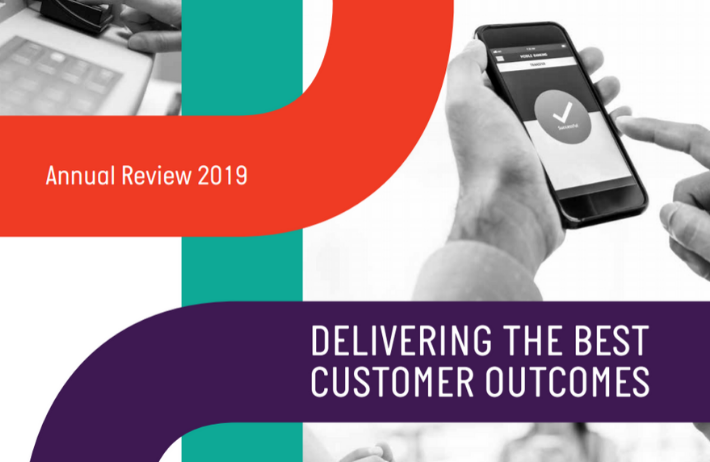
AusPayNet 2019 Annual Review Released
Australian Payments Network 2019 Annual Review
AusPayNet has released their 2019 Annual Review, which outlines their work this year.
AusPayNet 2019 Annual Review has been released.
As the payments industry association, AusPayNet’s network includes more than 130 members and participants. They bring together a diverse range of organisations including financial institutions, major retailers, payment systems operators and technology providers.
Highlights of the Annual Review include:
- A trust framework to improve customer convenience, privacy and security on our digital world
- A CNP Fraud Mitigation Framework to help the e-commerce community protect their customers and businesses.
- New standards enable merchants to offer card payments more cost-effectively and efficiently
- New guidelines underway to improve accessibility for people with disability
- New awareness programs to help those individuals and sectors that still use cheques transition to digital payments.
Find out more about AusPayNet’s key outcomes for 2019 and consumer payments trends by downloading the report here.
Source: Australian Payments Network AusPayNet

Mobile Payments Initiatives – What’s on the Cards for FY20?
Mobile Payments Initiatives – What’s on the Cards for FY20?
Upon successful launch of our Mobile Payments solution, Indue will be looking at a number of key mobile payments initiatives that will bolster the value and convenience of this digital technology for our clients.
Since the last quarterly industry update, Indue has successfully launched our Mobile Payments solution with Apple Pay and Google Pay alongside our lead client, BankVic. There was strong customer uptake on from the outset with a steady increasing trend in both customer sign-up and mobile transactions. So which mobile payments initiatives are next?
Indue is now gearing up for the launch of the first wave of new mobile clients scheduled for July-September 2019. The client list for the second wave is close to capacity and Indue is currently in the scheduling phase with these partners. In addition to enabling physical payment cards to be used for mobile transactions, Indue is working closely with a key client to commence the issuance of virtual gift cards. All processes relating to account setup, token provisioning and transaction processing is completed in the digital space enabling a quick and streamlined cardholder journey from card establishment to shopping cart.
Three New Product Pillars
Indue will be focusing on three key mobile payments initiatives for the Mobile Payments Product Roadmap:
1. eftpos Integration – Indue is currently working closely with eftpos to finalise requirements to integrate into the eftpos Token Service Provider (TSP). This project will see the establishment of secure infrastructure between Indue and eftpos to support the provisioning of mobile tokens for proprietary cards and multi-network debit cards.
2. In-App provisioning enables cardholders to provision their credit or debit card directly from their banking app to either Apple Pay or Google Pay mobile wallet by clicking on a button, which improves the customer experience by removing the need for cardholders to manually provision their card to an mobile wallet.
3. Instant Issuance – When a credit or debit card needs to be replaced lost/stolen scenarios, instant issuance enables a cardholder to continue to transact via their mobile wallet while waiting for their physical replacement card to arrive in the mail and then activate for use.
Indue will also look to commence the work to support other OEM wallets such as Samsung Pay, Garmin Pay and Fitbit Pay, thus broadening the Mobile Payments reach and adding to the value proposition our Mobile clients can offer to their customers.
Tokenisation is the New Black
The industry is establishing a framework to promote security and interoperability within card payments in a remote payment environment, which is currently referred to as the Secure Remote Commerce (SRC) protocol. One of the key tenets for this initiative is the use of tokenisation, which Indue already fully supports with our Mobile Payments offering. Tokenisation involves the transposition of original payment credentials (i.e. payment card number) with a digital ID or token. This removes the sensitive nature of the payment data and renders the information useless if compromised. Indue anticipates that the card schemes will mandate the use of tokenisation technology to target card-not-present fraud for ecommerce transactions, which will further leverage our Mobile Payments tokenisation infrastructure to support this industry initiative.
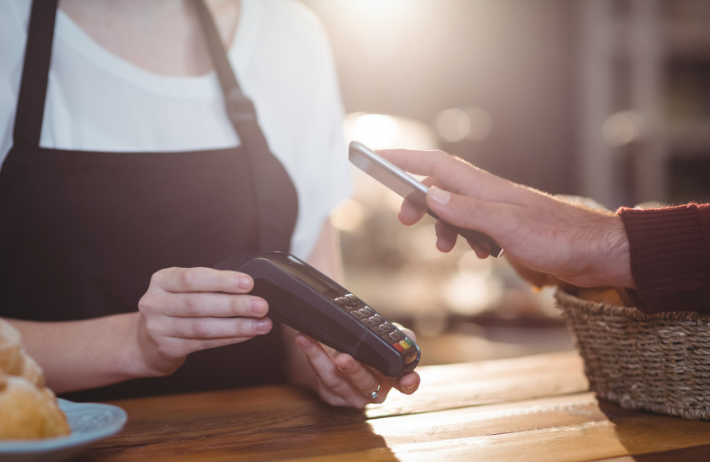
Smartphone Digital Wallets – $22b of bank revenue at risk
$22b of bank revenue at risk from smartphone digital wallets: Morgan Stanley
Smartphone digital wallets offered by Google, Apple and other technology giants will put $22 billion of revenue across the major Australian banks at risk, according to Morgan Stanley, forcing banks to lift digital investment to stay competitive.
Almost 30 per cent of banking revenue at Commonwealth Bank, or $6.7 billion, is under threat from global technology – such as smartphone digital wallets – seeking to cut banks off from their retail customers, which could also raise the cost of deposits, the report says. It finds CBA is best placed to respond given its large technology budget and the functionality of its banking app, which Morgan Stanley rates as best among the big four.
The report, the latest in the investment bank’s “Australia in Transition” series, comes a day after CBA chief executive Matt Comyn announced the bank would add a host of new features to its app to drive customers towards its own digital wallet. He said CBA had 2 million customers already using its digital wallet.
But Morgan Stanley said customers could find smartphone digital wallets provided by Google Pay, Apple Pay, Samsung Pay and PayPal more attractive, because they allow various cards and accounts from different financial firms to be linked, whereas the banks’ wallets only offer their own products.
Source: Australian Fintech ; $22b of bank revenue at risk from smartphone wallets: Morgan Stanley[
Source: This article first appeared on Australianfntech.com.au
Find out more about Indue’s Mobile Payments solutions.

How consumers are redefining customer experience
How consumers are redefining CX
In their 2019 Global Consumer Insights Survey, PwC introduces the concept of “ROX” as a way for companies to measure their success on the metric of customer experience.
The following article on customer experience first appeared on www.pwc.com.au on 26 Mar 2019. Author Chris Paxton
Customer Experience (CX) Key takeaways
- Customers are embracing technology in their pursuit of online goods and services.
- Brands wanting to increase spend and frequency should focus on the changing nature of customer experience.
- Friction-less interactions that integrate with a customer’s daily life and technology are key.
Is experience really everything? Yes, according to respondents of PwC’s 10th annual Global Consumer Insights Survey (GCIS).
Canvassing more than 21,000 consumers from 27 territories, the survey found consumers the world over want good customer experience when they shop. And what’s more, with the technology they have access to, they can now demand it.
On their wish list is an experience that is curated, channel-agnostic, socially conscious and social-media-powered. For some businesses, this is a tall order, and not one that has gotten enough attention in the past. Gone are the days when a pleasant smile is enough to gain customer favour.
Consumers, with technology at their fingertips, are redefining what good customer experience means.
Living digital
Technology is infiltrating daily life at breakneck speed. Mobiles, tablets and PCs are all being used for online shopping. This year, for the first time since the study has been run, mobiles overtook all other digital devices as the preferred shopping tool. Smartphones were reported as the go-to tech for purchasing, with 24% of respondents using a phone to shop at least weekly. The trusty PC is still close, though falling in favour, at 23% of consumers, while tablets bring up the rear at 16%

Online shopping is now the norm, with only 7% of people saying they never purchase products online.
As anyone who has coached a tech-wary relative on the ease of online banking can attest, people eventually become comfortable with the online experience. Over half of those surveyed paid bills or invoices online in the last year, with similar numbers transferring money. Entertainment, such as streaming movies and TV, is also booming, with 54% watching two to three times a week or more (over half of Gen Z streams daily).
Smartphones are also increasingly being used for payment, particularly in emerging regions where mobile phone use has leapfrogged traditional landline systems. While the technology’s prevalence is different depending on the country, globally, 34% of consumers have paid for a purchase via their mobile in 2018, up 10% on the previous year.
Frictionless shopping
Newton’s first law of motion states that a body in motion will continue to remain in motion until it is acted upon by an external force, that is, until it encounters friction. Customers, it turns out, are much the same. The less friction in their purchase journey, the more they’ll shop, and the more they’ll spend. Thirty-four percent of those surveyed said they shop more frequently due to having used Amazon, suggesting the experience – and likely its ease – encourages online shopping.
Voice assistants, such as Google Home or Amazon’s Alexa, are increasingly relevant to online shoppers with their AI hearts built around predictive, frictionless interaction (even if reality is still catching up with the promise). Nine percent of the global sample said they use the technology weekly or more. As the report notes, however, “as shopping by voice continues to catch on, companies should be thinking beyond mobile to consider how voice technology in homes, cars, and elsewhere will affect customer experience”.
Anything that adds friction will not be looked upon kindly. Click-and-collect functions, already adopted by 42% of Australian retailers, are gaining favour in the US (under the acronym BOPUS, or ‘Buy Online and Pick Up in Store’), but customers need to be helped through the experience before they will trust it – and that’s where employees come in.^
The human-digital touch
While customers want to interact with brands via digital means, this doesn’t mean they want humans out of the picture entirely.
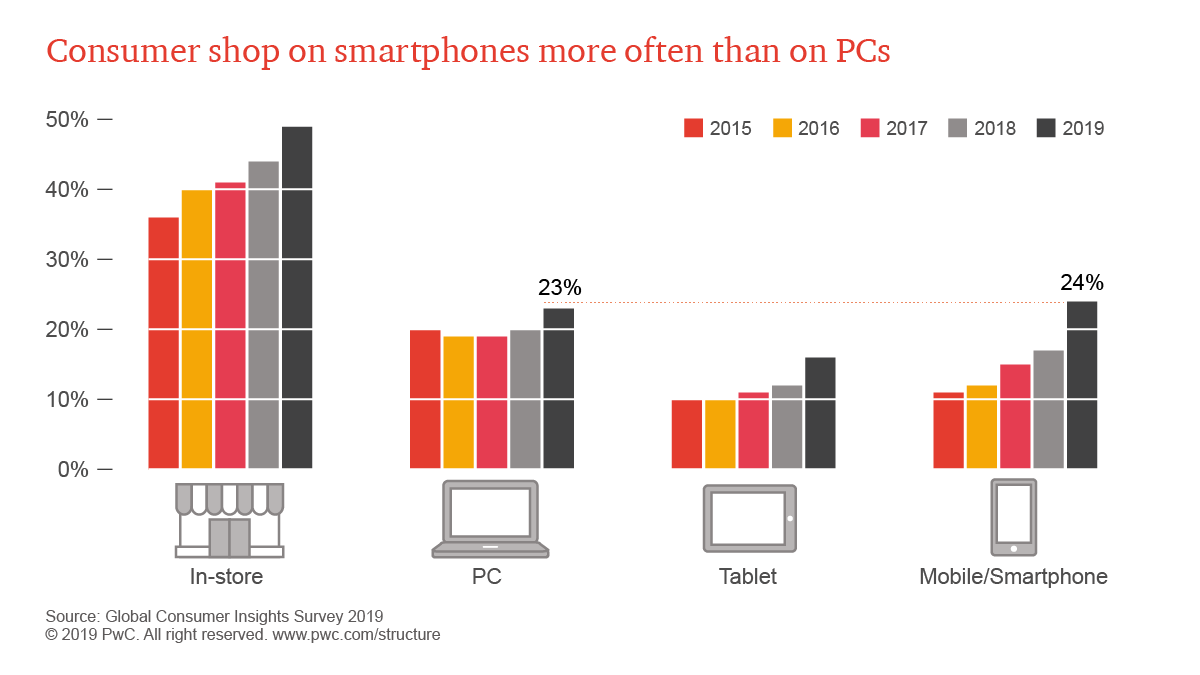 This year, smartphones have proven more popular than PCs when it comes to purchasing online, but in-store shopping is still popular. How can brands manage the mix of in-person and digital experiences?
This year, smartphones have proven more popular than PCs when it comes to purchasing online, but in-store shopping is still popular. How can brands manage the mix of in-person and digital experiences?
In PwC’s Consumer Intelligence Series report on customer experience last year we found that 59% of those surveyed believed that companies had lost touch with the human element by focusing too much on tech. One of the takeaways was that brands needed to have a good mix of technology and staff, and in particular, have tech that empowered employees to provide superior service.This finding is echoed in the current survey, particularly as regards financial services, where only 15% had purchased insurance via a digital channel, only 13% had gotten a loan and only 12% made a financial planning decision. For this industry, and others, more education is required by the customer before they feel comfortable in making a purchase. A blended experience, where in-person interaction is mixed with digital experiences throughout the journey, can prove far more fruitful in these instances.
Dreaming big
When it comes to redefining customer experience, it is also apparent that not only are consumers increasingly more willing to try online purchasing, they’re ready to increase what they do online in other ways. Almost 75% of consumers have installed as many as three health or wellness apps on their phones, and two-thirds of those surveyed are willing to access such services through nontraditional players – such as Facebook, Apple or Amazon.
 Health and wellness apps are enjoying wide adoption by consumers – particularly for weight loss and exercise.
Health and wellness apps are enjoying wide adoption by consumers – particularly for weight loss and exercise.
Health is not the only example when it comes to pushing traditional boundaries. Forty-six percent of consumers would like to have, or will consider having, an autonomous vehicle. Fifty-eight percent would consider investing in or using bitcoin or another digital currency.
It’s clear that customers are expanding their digital horizons and, as they explore, their expectations will grow with them. For brands, this means delivering a superior customer experience the entire length of the journey customers take.
Sources
This article was originally published on www.pwc.com.au. For all the insights from the Global Consumer Insights Survey, download the full report here.
^ https://www.abc.net.au/news/2017-08-30/click-and-collect-why-retailers-are-pushing-shoppers/8856504
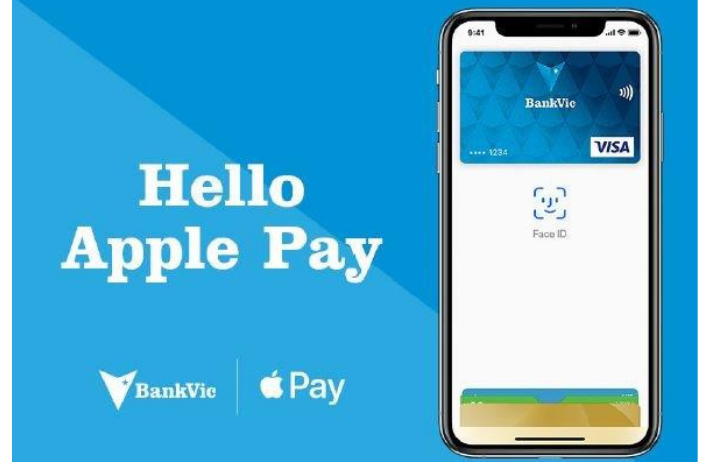
Press Release – Apple Pay now available to Indue clients
Apple Pay now available to Indue clients (BankVic first to market)
PRESS RELEASE 02/04/19 – Indue Limited today brings Apple Pay to its clients with BankVic first to market.
SYDNEY, NSW — 2 April, 2019
Apple Pay is transforming mobile payments with an easy, secure and private way to pay, that’s fast and convenient, and is available for Indue’s clients and their customers who have an eligible Visa debit and credit card from today. By introducing Apple Pay, Indue’s clients across financial services, retail, fintech and government sectors can provide customers a simpler and more engaging payment experience and BankVic members will be the first to benefit.
Security and privacy is at the core of Apple Pay. When you use a credit or debit card with Apple Pay, the actual card numbers are not stored on the device, nor on Apple servers. Instead, a unique Device Account Number is assigned, encrypted and securely stored in the Secure Element on your device. Each transaction is authorized with a one-time unique dynamic security code.
Derek Weatherley, Indue CEO said, “Consumers expect fast, convenient and secure payments and Indue is very excited to introduce Apple Pay. Indue’s mission is to ensure that the millions of Australians that access their money through our client companies have access to market leading payment products and we are proud to have delivered on that again today with the launch of Apple Pay’.”
BankVic CEO Anthony De Fazio said, “At BankVic, we are always looking to provide simple and more convenient ways for our members to bank with us, thanks to the support from Indue, we are pleased to offer Apple Pay as a new mobile payment solution.”
Apple Pay is easy to set up and users will continue to receive all of the rewards and benefits offered by credit and debit cards. In stores, Apple Pay works with iPhone SE, iPhone 6 and later, and Apple Watch.
Online shopping in apps and on websites accepting Apple Pay is simple with Touch ID, or just double-click the side button and authenticate with a glance with Face ID. There’s no need to manually fill out lengthy account forms or repeatedly type in shipping and billing information with Apple Pay. When paying for goods and services in apps or Safari, Apple Pay works with iPhone 6 and later, iPhone SE, iPad Pro, iPad (5th Generation and later), iPad Air 2, and iPad mini 3 and later. You can also use Apple Pay in Safari on any Mac introduced in or after 2012 running macOS Sierra and confirm the payment with iPhone 6 or later or Apple Watch, or with Touch ID on the new MacBook Pro.
For more information on Apple Pay, visit: www.apple.com/au/apple-pay
About Indue: Indue is a bank regulated by the Australian Prudential Regulation Authority. Australian owned and operated, Indue has over 45 years’ experience in the payment industry and provides payment solutions to a broad range of organisations. Indue is wholly owned by financial institutions, all of which have their heritage in the mutual and credit union sector.
More Information
For further information please contact:
- Ashlea Crichton, Manager Rowland Communications
- [email protected]
Download the Press Release here

Trend Report Delves into the Benefits of Mobile Wallet Payments
Trend Report Delves into the Benefits of Mobile Wallet Payments
Speedpay Pulse considers the Impact of the “Mobile Mind Shift”
For many consumers, smartphones are an integral aspect of their lives. According to Pew Research Center, 77 percent of Americans now own smartphones, up from just 35 percent from the organization’s 2011 smartphone ownership survey. As consumers have become more comfortable utilizing their smartphones for everyday tasks, many companies have simultaneously enhanced their pay by mobile wallet capabilities to cater to consumer preference. This offering includes any technology that stores payment card information, whether native to your smartphone, or via downloadable third-party payment methods.
(Source “Speedpay Pulse Trend Reports”)
Transitioning to Digital
According to the Speedpay® Pulse, a consumer billing and payments trend survey of 3,000 U.S. adults responsible for two or more household payments a month, one in four consumers currently use mobile wallet payment methods and nearly half (47.6 percent) of those people use mobile wallet offerings multiple times a week. Due to an increase in mobile wallet usage, retailers have begun offering loyalty rewards and other incentives, and based on their research, these strategies seem to be working. Of those who use mobile payment methods, 82.2 percent report using one to three methods and applications on a regular basis. The numbers were almost the same for non-payment items, as 80 percent of those who use mobile wallets also take advantage of options such as digital tickets and boarding passes.
Due to the ease and convenience of these offerings, mobile wallets are becoming the new normal, which could eventually remove the need for consumers to pack a physical wallet and smartphone each day.
 The Impact of the Mobile Mind Shift
The Impact of the Mobile Mind Shift
The growing adoption of smartphones and apps has essentially shifted consumer attitudes. Due to this change, mobile wallet payment options have become a necessity for companies, especially because this particular type of transaction is gaining traction for bill pay. Many consumers find that mobile wallet payments provide a simple, convenient payment option, unlike traditional cash and check payments. According to their most recent report, approximately 33 percent of consumers said they would consider using a mobile wallet to pay bills in the future. The top two reasons reported were speed (55 percent) and convenience (51 percent).
Weighing the Option of Adopting Mobile Wallet Payments
Many companies are still reluctant to adopt mobile wallet payments; however, in order to meet the needs of consumers, they should consider implementing mobile wallet offerings. By catering to consumer preference and interacting with them via their smartphones, companies can help ensure an easier and more seamless payments experience. Additionally, the reminders offered via mobile wallet are very beneficial and provide a convenient way to remind their customers to pay. Many mobile wallets have the capability to send monthly statements and notifications directly to a customer’s smartphone, which offers an additional communications channel. Lastly, if companies consider adopting mobile wallets, they will be able to increase self-service and digital engagement among customers, which can lead to a decrease in paper usage and overall operational costs.
Mobile wallet payments will continue to gain popularity in the foreseeable future. Whether customers are paying their bill with a physical debit/credit card or via mobile wallet, it’s recommended that companies constantly communicate with their customers to provide them with a convenient and seamless payments experience.
Article first published 19 February 2019, www.paymentsjournal.com Author Alexis Blackstead
Source: www.paymentsjournal.com Read full article here. To learn more about consumers’ mobile wallet payment preferences, download the Speedpay Pulse Trend Report here.

Payments in the Digital Age
Payments in the Digital Age
With the ability to make a purchase with your smartphone or watch or reusable coffee cup, it has truly become a digital world out there.
And if the recent Australian consumer turnout to the notoriously American-loved tradition of Black Friday is any indication of future trends, the migration to this new world is only going to increase. According to AusPayNet’s recent findings highlighted in their 2018 Annual Review, Australians continue to flock to online shopping with e-Commerce transactional value increasing 16.7% from last year and ATM withdrawals decreasing by 4%. Whilst it will be a while before Australia becomes a cashless society, it is clear that Australia is well prepared being ranked 10th amongst 118 countries for its digital readiness. So what are the implications of such a seismic shift in payments? Who will benefit? What are the risks? How can institutions leverage this trend?
Keeping Pace in the Digital Race
Consumers will naturally gravitate towards processes that make their lives easier. Paying for a well-earned smoothie after a long run using a watch and without the need to carry cumbersome cash. Immediately transferring money to a friend after he buys a round of drinks on a Saturday night using a smartphone. Replenishing the stock in your pantry with a click of a button on the smart fridge. It is undeniable that in addition to online shopping or the ease of tapping a payment card to make a purchase, convenience has become a key motivator for digital payment innovation.
Financial Institutions and even historically non-payment related companies such as Apple and Google are looking to make the consumer journey quicker and easier. Vying for some real estate in this digital realm are also the smaller fintechs that can typically mobilise and adapt to change rapidly. These smaller players are introducing valuable services and offerings in the Australian payments market, but also more broadly in leading, data analytics, wealth management. The emergence of digital banks or neobanks is also providing the traditional financial institutions a run for their money. These banks operate entirely in the digital space and might be attractive to consumers given their ability to potentially offer higher interest rates for accounts and lower fees given the lack of overhead required to maintain physical branches. Competition for a consumer’s digital payment is fierce, which means that companies that can quickly innovate and provide an offering to consumers that leverages the thirst for convenience will win out.
KYC: Know Your Customer = Keep Your Customer
Understanding how different demographics are transacting in the digital age is invaluable in tailoring the transaction journey for the end user. Innovation is not necessarily the only means of attracting and retaining customers. Simply refining existing processes can ensure relevancy in the digital market. For example, the use of a mobile number or email address instead of the traditional BSB and Account Number to transfer funds. In a recent article published by KPMG, “Banking on the Future”, Generation Y professionals (defined as aged between 18-30, university educated, relatively well paid, tech savvy and global minded) were identified as an important target for financial institutions in the imminent future. These young professionals will be instrumental to how financial institutions will shape products and services in the payment industry as they represent 22% of the population and 50% of the workforce in the next five years.
One example is the preference for invisible payments – this demographic enjoys the convenience of making a payment without having to reach for their wallet. Uber is a perfect example of allowing the user to launch a service without having to exchange payment credentials with the driver for every transaction. It is set and forget. Financial institutions should look to tap into the preferences and attributes of specific demographics in the digital age as this will enable products and services to be personalised to their customers. The aim is to demonstrate relevancy in this ever-changing payment landscape, but also to ensure customer satisfaction and retention.
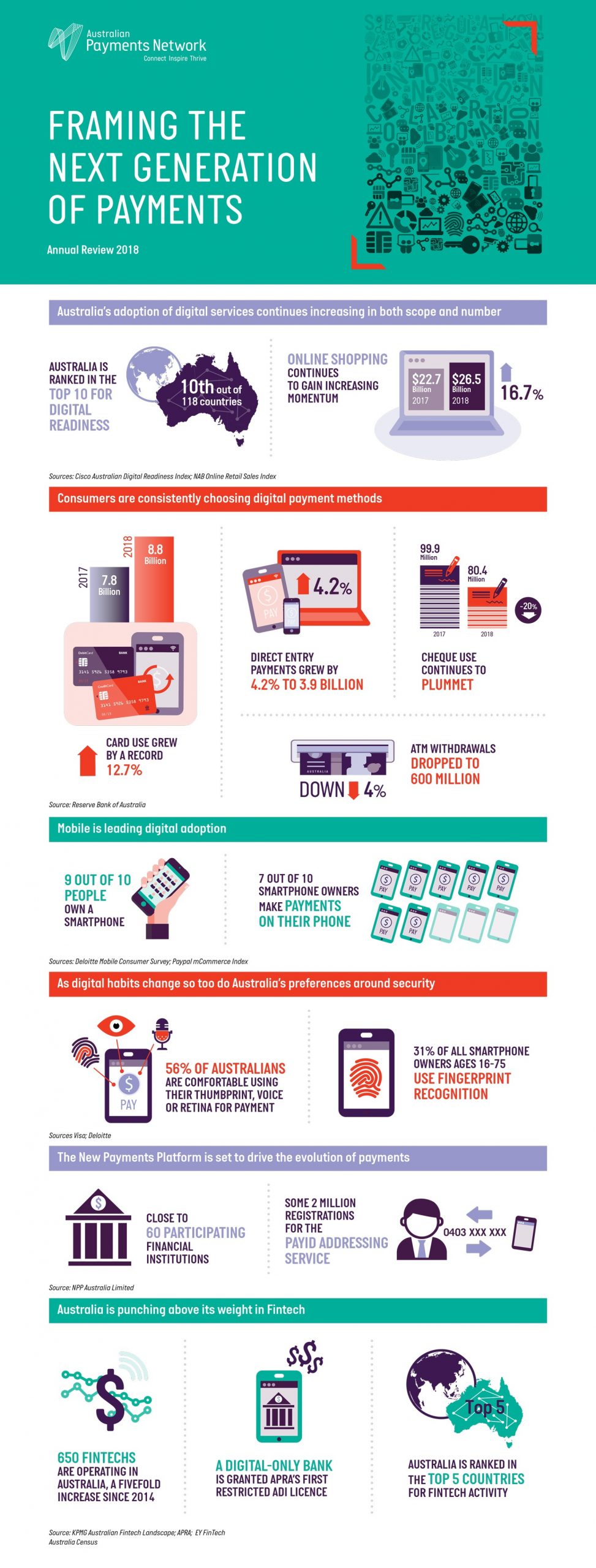
Fraud Evolution
The speed with which payments can now be made introduces a new challenge – how can the payment industry continue to provide assurance to a customer that the transaction is still secure? In the past decade, the payment industry has worked tirelessly to introduce EMV capabilities via microchips to physical plastic payments cards that provides an additional layer of security for card-present transactions. With a heavy sway towards online shopping now, the industry must ensure that this payment channel is secured in such a way as to provide consumers with confidence that they are not compromising security for convenience. The payment industry implemented EMV Three-Domain Secure (3DS), which is a messaging protocol to enable consumers to authenticate themselves with their card issuer when making card-not-present (CNP) eCommerce purchases. The additional security layer helps prevent unauthorised CNP transactions and protects the merchant from CNP exposure to fraud.
Even with these security protocols in place, CNP fraud is increasing. In response to this trend, the payment industry is working with AusPayNet to put together a collective CNP Fraud Mitigation Framework. The aim is to collaboratively establish a framework to reduce CNP fraud by understanding the immediate fraud threats, but also planning for future changes in the digital payment landscape. The industry is also undertaking an approach to promote security and interoperability within card payments in a remote payment environment, which is currently referred to as the Secure Remote Commerce protocol. One of the key tenets for this initiative is the use of tokenisation, which is a strategy that Indue has implemented with its mobile payments offering. Tokenisation involves the transposition of original payment credentials (i.e. payment card number) with a digital ID or token. This removes the sensitive nature of the payment data and renders the information useless to a fraudster. In the fast-changing world of digital payments, the potential fraud opportunities will undertake the same degree of evolution. It is critical that the payment industry adopt fraud prevention strategies that align with the speed with which payments are evolving.
Digital payments is certainly the way of the future. The Australian payment industry as a whole will benefit from not only all of the new capabilities that will be introduced in the near future, but also the competition that will generated by all of this industry movement.

Cashless Payment Technology is Helping Business Thrive
Cashless Payment Technology in Helping Business Thrive
The days when a trip to the ATM was compulsory before strolling to your local market are numbered. Instead small businesses now find themselves faced with the new breed of “cashless consumer”, and adapting to suit.
According to a recent survey by the RFi Group, 32 per cent of Australians believe they can go cashless. Fortunately, the advent of low-cost and low-fuss technology allows local businesses, including sole traders, to sell their products and services quickly and easily, whether it’s a small item or a more expensive impulse purchase.
A Shift In Mindset
Michael McQueen, retail trend forecaster and bestselling author of How to Prepare Now for What’s Next, says small businesses have traditionally avoided cashless transactions because options were limited and merchant fees were often high.
“However, with the multitude of merchant options now available and costs coming down, it is feasible, profitable and even essential to offer cashless transactions on even small-priced items,” he told SmartCompany.
“It has required business owners to change their paradigm about cashless transactions and, to their credit, many have.”
McQueen says small businesses need to be able to become more agile when it comes to payments, or they simply won’t survive.
“Businesses that still see cashless trading as a privilege they extend to high value sales and customers will continue to be left behind – becoming as out-of-touch as the paradigm driving their approach,” he says.
“Within a few short years, accepting cash only will indicate little more than that you are trying to dodge tax because there will be no other legitimate reason to holding this stance.”
Opportunities Galore
McQueen says adopting varying payment technologies will open up more opportunities for growth but also help small businesses retain their local flavour.
“The biggest opportunity is that cashless transactions encourage more spontaneous spending,” he says.
“There is no need for technology use to come at the cost of service levels and a sense of local connection. If the transaction is seamless, easy and fast, this frees up businesses to focus on engaging, serving and delighting their customers rather than simply transacting with them.”
Nate Thoreson is the owner of small Melbourne-based business St Kilda Rickshaws, which hires out rickshaws for private events such as weddings and corporate public events including the Australian Open tennis tournament.
He says customers are very comfortable with cashless money transfer systems and it has now become their primary mode of payment.
“Four years ago, most of our private event hire jobs were settled using cash – now it’s the opposite, most of our events are paid for using credit card,” he says.
“Apart from being easier as people don’t have to swing by the ATM anymore, it really helps customers understand their spending habits and also find opportunities to improve their budgeting.”
Let’s Not Forget The Data
Using payment technologies offers traders more information on their customers than ever before. This means business owners can use data to make their businesses more discoverable to the right customers via other low-cost platforms, such as social media.
“Beyond encouraging increased spontaneity and discretionary purchases, the coming years will likely see small businesses be able to access data on consumer spending patterns that have previously only been available to large-scale businesses,” McQueen says.
“Accessing and utilising this is not complex of expensive – it just requires knowing where to look and being willing to invest the time/energy to do so.”
The Face of the Future
McQueen says the biggest trend in the payment space in the short to medium future will be that of biometric payments.
He says Alipay in China have begun trialling a system where customers literally ‘pay by smile’ – a register recognises their face and charges a transaction to the credit cards stored again their Alipay account.
“Amazon’s recently-launched Amazon Go stores also offer an exciting insights into the future of retails/grocery transaction with their stores that automatically tally a customers shopping cart as they stop removing the need for cash registers, check outs or a transactional interface at all,” he says.
Thoreson says his company is always looking out for new tech to make their operations more streamlined and profitable.
“As technology moves and changes so quickly, it’s important to keep an eye on what’s happening,” he says.
Source: Smart Company April 10th, 2018
Enquire now about our cashless payment solutions!


